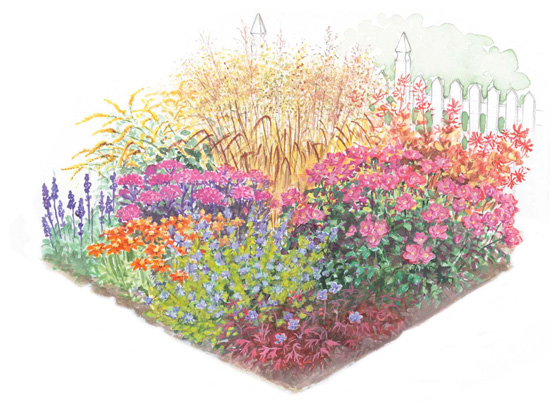
WITH SO MANY FANTASTIC FLOWERING, FRUITING, AND FOLIAGE plants to choose from for fall interest, it can be tempting to plan a whole landscape around them, and the results could be simply spectacular. Of course, most of us want gardens that look great in spring and summer, too — and we can have them, if we’re willing to put a little extra care into selecting our plants and combining them effectively.
In the following pages, you’ll find ten examples of gardens that can grace your yard in autumn as well as one or more of the other seasons. Use the plans as they are, modify them to fit your particular needs, or take the design suggestions as a jumping-off point for your unique planting plans. Once you start looking at gardens with an eye toward autumn interest, you’re likely to find lots of ways to extend the beauty of your existing plantings as well. Checking out other gardens and getting inspiration from pre-made plans are valuable ways to get ideas, but the best way to explore the glories of the fall garden is to just get out there and get planting!
Sunny sites offer an abundance of exciting options for all seasons, but they’re particularly pleasing for fall gardens because they support the widest variety of flowering and fruiting plants. Ample sunlight also tends to bring out the brightest hues in leaves that change color in autumn, adding even more plants to the designer’s palette. While there are sun-lovers for all parts of the border, bright sites are a real boon for gardeners who like big plants. Some fall perennials use the summer sun’s energy to shoot up 6 to 10 feet tall before their flowers even think about opening — perfect for filling big spaces or for providing seasonal screening for a deck, pool, or other outdoor living space. Luckily for space-challenged gardeners, there are also plenty of more-compact cultivars of these sub-stantial perennials to bring bright blooms down to a more manageable size.
An expanse of lawn is an easy way to fill a sun-drenched front yard, but it doesn’t add much in the way of ever-changing color and texture. You don’t want to replace that useless turf with just any plants, though. In such a visible spot, they need to look great both before and after their bloom season, not just while they are in full flower. A street-side border should also be low-maintenance, so you’re not stuck spending a lot of time kneeling or bending over out there in full view of neighbors and passersby.
This design is packed with hardworking, easy-care, non-fussy plants that provide an abundance of color and texture from foliage, flowers, and seed heads from mid-spring through fall — and well into winter too. All it needs is a bit of grooming once or twice a year (prune out any deadwood on the rose and trim back the caryopteris to about 1 foot tall in early spring; cut the rest of the perennials back to the ground in either late fall or early spring). After the chance of frost has passed, pop in a six-pack of ‘Profusion Orange’ zinnias along the front, then stand back and enjoy your sunny border as it gets better and better through the growing season!
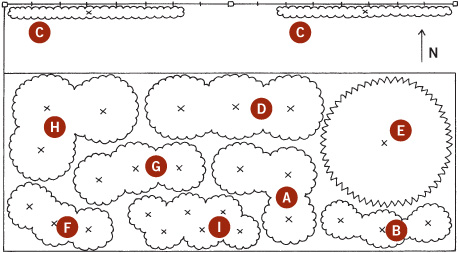
A Caryopteris incana ‘Jason’ (3 plants)
B Geranium ‘Brookside’ (3 plants)
C Lonicera × brownii ‘Dropmore Scarlet’ (2 plants)
D Panicum virgatum ‘Northwind’ (3 plants)
E Rosa ‘Radrazz’ (1 plant)
F Salvia ‘Caradonna’ (3 plants)
G Sedum ‘Black Jack’ (3 plants)
H Solidago rugosa ‘Fireworks’ (3 plants)
I Zinnia ‘Profusion Orange’ (6 plants)
SUNSHINE BLUE CARYOPTERIS
Small, bright yellow leaves from spring through fall; bright blue flowers in early to mid-fall. 2'—3' tall × l'—2' wide. Full sun (in cooler areas) to partial shade; average, well-drained soil. Zones 5—9. Suggested alternative: C. × clandonensis ‘Worcester Gold’ (blooms a few weeks earlier and is not quite as bright yellow in leaf).
‘BROOKSIDE’ GERANIUM
Deeply lobed green foliage turns bright red in fall; blue flowers from late spring to mid- or late summer. About 30" tall and wide. Zones 5–8.
Suggested alternative: ‘Rozanne’ (more spreading than upright and starts blooming later, but continues well into fall and has reddish fall leaf color).
‘DROPMORE SCARLET’ HONEYSUCKLE
Oblong green leaves turn shades of yellow, orange, and red in fall; reddish orange flowers from early or midsummer well into fall, often followed by red berries. Can grow 10'—15' tall (size depends on the size of the support structure). Full sun to light shade; average, well-drained soil. Zones 4—8.
Suggested alternative: L. × heckrottii (goldflame honeysuckle; flowers are deep pink outside and peachy yellow inside).
‘NORTHWIND’ SWITCHGRASS
Slender, olive green blades that turn shades of yellow in fall and then tan through the winter; airy greenish to tan flower heads appear in late summer and last through winter. 5'—6' tall × 1'—2' wide. Full sun; average, well-drained soil. Zones 4—9.
Suggested alternative: ‘Heavy Metal’ (not quite as strongly upright and slightly shorter, with blue-green foliage).
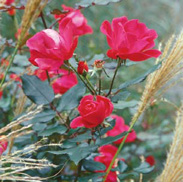
Rosa ‘Radrazz’
KNOCK OUT ROSE
Roughly oval, deep green leaves may turn deep purple in fall; bright reddish pink, semi-double flowers from early summer well into fall, followed by orange hips. 3'—4' tall and wide. Full sun to light shade; average to moist but well-drained soil. Zones 4—9.
Suggested alternative: ‘Radtko’ (Double Knock Out; with double flowers).
‘CARADONNA’ SALVIA
Small, medium to deep green leaves on purple stems through the growing season; spikes of deep purple-blue flowers from midsummer into fall with deadheading. About 2' tall × 18" wide. Full sun; average, well-drained soil. Zones 4—8. Suggested alternative: S. ‘Blue Hills’, ‘East Friesland’, or ‘May Night’ (about 18" tall); Veronica ‘Goodness Grows’ (even shorter and more mat-forming, with bright blue flowers).
‘BLACK JACK’ SEDUM
Oblong, deep purple leaves all through the growing season; broad heads of tiny, rosy pink flowers open in early fall and hold their form well into winter. About 2' tall × 1' wide. Full sun to light shade; average, well-drained soil. Zones 3—8. Suggested alternative: ‘Purple Emperor’, or another dark-leaved, upright sedum.
Solidago rugosa ‘Firewoks’
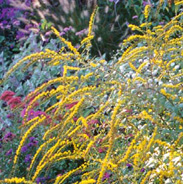
‘FIREWORKS’ GOLDENROD
Slender, deep green leaves all season; sprays of bright yellow flowers from late summer into fall. 3'—4' tall × about 2' across. Full sun to light shade; average, well-drained soil. Zones 5—9.
Suggested alternative: Rudbeckia fulgida var. fulgida (shorter, with dark-centered, bright yellow daisies).
‘PROFUSION ORANGE’ ZINNIA
Small green leaves from spring to frost; bright orange, single blooms from early summer until frost. 12"—18" tall and wide. Full sun; average, well-drained soil. Annual.
Suggested alternative: Gaillardia × grandiflora ‘Oranges and Lemons’ (perennial, with larger but lighter orange-and-yellow flowers).
Regardless of whether you decide to do your main garden cleanup in fall or spring, there’s still plenty to do to get your yard ready for winter. Here’s a tip that will make any cleanup job go a bit easier: Instead of using a bucket or wheelbarrow to gather the debris, spread out a tarp right next to the area you’re working on and toss all the clippings onto it as you cut. When you’re done, simply pick up the four corners and drag it over to your compost pile. That’ll save you the separate step of raking up the debris and stuffing it into a cart or wheelbarrow, and you won’t need to make endless trips back and forth to pick up everything.
Handling annuals. Generally, it’s a good idea to remove the annuals from your gardens in fall. Most of them don’t add much in the way of winter interest, and many look downright ugly once they’ve been zapped by cold. Lots of annuals can bloom until a light or hard frost, so wait until they’ve been blackened to remove them. (Impatiens and begonias are two exceptions; if they get frosted, they turn slimy and are unpleasant to handle, so remove them soon before frost.) Pull out the plants, roots and all, or clip the stems right at ground level and leave the roots to decompose and thereby add organic matter to the soil.
Cutting down perennials. If you’ve decided to cut down some or all of your perennials now, wait until they are fully dormant—in late fall or even early winter. If you cut too early and the weather stays mild, they might decide to resprout and use up their stored energy in the process, reducing the chance they’ll overwinter successfully. Use hand shears to snip individual stems, or try hedge shears or even a string trimmer to make quick work of multiple plants. Don’t cut too close to the ground or you might damage the crowns; about 3 inches above the ground is fine for most plants.
Removing leaves from ground cover.
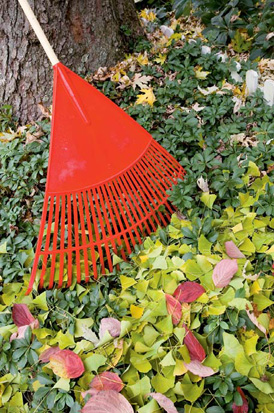
Cleaning up leaves. Before you count your cleanup chores as done, take a little time to inspect the rest of your yard. If any ground covers are buried in fall leaves, rake them off. (It’s fine to leave some of the leaves, because they’ll act as a good organic mulch; you just don’t want a lot of leaves sitting on top or they’ll smother the ground cover.) If any of your shrubs or trees showed signs of leaf diseases this past growing season, it’s a good idea to rake up their dropped leaves, along with the top layer of mulch. Then give them another inch or two of fresh mulch to cover any remaining spores and reduce the chance of disease problems next year.
It’s easy to create a flower-filled shade garden for spring: Sunlight is abundant before the trees leaf out, and many woodland wildflowers take advantage of this opportunity by putting on their bloom display early in the growing season. Once the spring show of flowers is over, foliage tends to take center stage, but that doesn’t mean you have to settle for solid shades of green. Choosing plants with distinctive leaf textures and colors ensures that your shady garden is as appealing in autumn as it is in spring. Tuck in a few shade-loving fall-bloomers too, and you’ll enjoy some seasonal surprises to complement the long-lasting display of beautiful leaves.
This foliage-based, multiseason mixed border offers a veritable rainbow of colors from spring through fall, along with winter interest from some ever-present leaves (including the autumn ferns, heucheras, Lenten roses, and wild gingers). Flowers aren’t lacking, either, from the late-winter blooms of Lenten roses to the fragrant white blossoms of fothergilla in spring; the heucheras and foamy bells in early summer; and the hydrangea, black snakeroots, toad lilies, and yellow waxbells in late summer and fall.
From a practical standpoint, this design focuses on dependable plants that don’t demand a lot of fussing, trimming, or deadheading. After all, you want to be able to relax on your deck — not feel guilty about a garden that needs endless maintenance. An hour or so in late winter should suffice for cutting down any remaining winter-killed top growth on the perennials, trimming the old leaves off the Lenten roses, and adding some fresh mulch if needed; beyond that, the plants pretty much look after themselves.
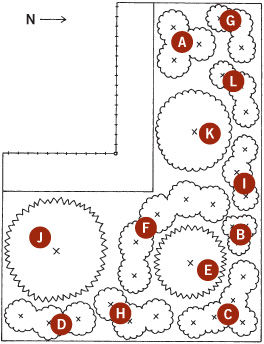
A Actaea simplex ‘James Compton’ (3 plants)
B Asarum europaeum (3 plants)
C Carex siderosticha ‘Lemon Zest’ (5 plants)
D Dryopteris erythrosora ‘Brilliance’ (3 plants)
E Fothergilla ‘Blue Shadow’ (1 plant)
F Helleborus × hybridus (5 plants)
G Heuchera ‘Lime Rickey’ (3 plants)
H Heuchera ‘Peach Flambé’ (3 plants)
I × Heucherella ‘Stoplight’ (3 plants)
J Hydrangea quercifolia ‘Little Honey’ (1 plant)
K Kirengeshoma palmata (1 plant)
L Tricyrtis formosana ‘Gilt Edge’ (3 plants)
‘JAMES COMPTON’ BLACK SNAKEROOT
Lacy, deep purple-brown foliage; brushy white flower spikes in late summer to early fall. 3'—4' tall × 2' wide. Partial shade; moist, well-drained soil. Zones 4—8. Suggested alternative: Actaea simplex ‘Black Negligee’ (usually 4'-5' tall).
EUROPEAN WILD GINGER
Kidney-shaped, glossy deep green leaves effective all year; small, brown ground-level flowers in spring. About 4" tall × 6"—12" wide. Partial to full shade; average, well-drained soil. Zones 4—9. Suggested alternative: Hexastylis shuttleworthii.
‘LEMON ZEST’ SEDGE
Broad, spiky, bright yellow blades turn greenish yellow in summer; last through fall. About 10" tall and wide. Full sun to partial shade; evenly moist but well-drained soil. Zones 5—9. Suggested alternative: Carex ‘Banana Boat’.
‘BRILLIANCE’ AUTUMN FERN
Lacy fronds are coppery orange when new, maturing to deep green and lasting through much or all of the winter. About 2' tall and wide. Partial shade; average, well-drained soil. Zones 5—9.
Suggested alternative: Dryopteris erythrosora.
‘BLUE SHADOW’ FOTHERGILLA
Rounded blue-gray to blue-green leaves in spring/summer turn red, orange, and yellow in fall; brushy clusters of white flowers in spring. 5'—6' tall and wide. Full sun to partial shade; slightly acidic, average to moist, well-drained soil. Zones 5–8. Suggested alternative: F. gardenii ‘Blue Mist’.
HYBRID LENTEN ROSE
Deep green foliage is present year-round; saucer-shaped white, pink, or deep red flowers from late winter to mid-spring. 12"—18" tall and about as wide. Partial to full shade; average, well-drained soil. Zones 5—9. Suggested alternative: H. foetidus.
Heuchera ‘Dolce Key Lime Pie’
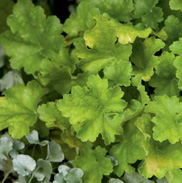
‘LIME RICKEY’ HEUCHERA
Bright yellow new foliage ages to greentinged yellow and is effective into winter; airy clusters of tiny white flowers in summer. About 1’ tall and wide in leaf; to 18" tall in bloom. Light shade; average, well-drained soil. Zones 4—8. Suggested alternative: ‘Dolce Key Lime Pie’ heuchera.
‘PEACH FLAMBÉ’ HEUCHERA
Orange-pink to orange-brown foliage is present year-round; airy clusters of tiny white flowers in summer. About 1' tall and wide in leaf; to 18" tall in bloom. Light shade; average, well-drained soil. Zones 4—8. Suggested alternative: ‘Mardi Gras’ or another orange- or purple-leaved heuchera.
‘STOPLIGHT’ FOAMY BELLS
Bright yellow foliage with red center markings, especially in spring (may go summerdormant but looks good again in fall); white flowers in spring. About 6" tall × 1' wide in leaf; 12"—18" tall in bloom. Partial shade; average, well-drained soil. Zones 4—8. Suggested alternative: ‘Sunspot’.
‘LITTLE HONEY’ OAKLEAF HYDRANGEA
Lobed yellow leaves turn red in fall; large-clustered white flowers in late summer. About 3' tall and wide. Partial shade; average to moist, well-drained soil. Zones 5—9. Suggested alternative: ‘Pee Wee.’
YELLOW WAXBELLS
Large, lobed green leaves all through the growing season; yellow, bell-shaped blooms in late summer to early fall. Usually 3'—4' tall and wide. Partial shade; slightly acidic, evenly moist but well-drained soil. Zones 5–8. Suggested alternative: Hosta ‘Great Expectations’.
‘GILT EDGE’ TOAD LILY
Glossy green leaves edged with yellow are present all season; purple-spotted white flowers start in summer and continue into fall. 1’—2' tall × about 2' wide. Partial shade; average to moist but well-drained soil. Zones 6—9.
Suggested alternative: T. hirta ‘Miyazaki Gold’ or T. formosana ‘Samurai’.
Both shady and sunny gardens present you with the same challenge at the end of the growing season: What are you going to do with all the dead leaves and trimmings? The 3 R’s (reduce, reuse, and recycle) are finally becoming commonplace for household trash, and they’re just as effective for handling yard and garden waste. With a little know-how, you can turn even a large pile of debris into a welcome source of soil-building material. If you have enough temporary storage space, gather up the leaves, stems, and other trimmings in fall, then pile them up to deal with later; it’s a great reason to get outdoors for a few hours on a mild winter day! Or, take care of them as part of each day’s cleanup, and you won’t be stuck looking at unsightly debris piles in your backyard.
Mulching on the spot. For the ultimate in time savings, go ahead and chop up dead stems right in the garden. Simply cut them off just above the base, hold them in one hand, and use your pruning shears to snip them into small pieces so they fall right back into the garden. No hauling away, no piles of debris—just an instant mulch. This works best when you’re dealing with small beds, lots of fairly soft or thin stems, or fairly short cleanup sessions; after a while, your hands can get rather tired! Keep a bucket nearby to hold the small bits you don’t want to return to the garden, including seed-filled seed heads and diseased leaves.
Leave some leaves. Instead of raking up all of the leaves from your trees and shrubs, let at least some of them stay where they fall. This works best in beds, borders, ground covers, and foundation plantings, where the leaves can decompose and release nutrients and organic matter right where they’re needed. If the leaves are so large or so numerous that they cover the plants or grass, then rake them up so they don’t smother your garden or lawn. Add them to your compost bin, pile them up to make leaf mold, or shred them with your lawn mower and dig them into your soil or use them for winter mulch.
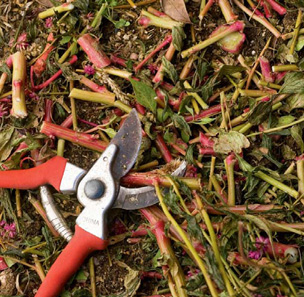
Chopping tender stems into the garden.
Handling the hard stuff. The most challenging type of garden waste to deal with is tough stems and woody branches. If you have a small amount of this durable debris, you could either chop it up manually with loppers or smash it with a hammer and add it to your compost pile. (Smashing exposes more surface area for quicker decomposition, but it will still take awhile to break down.) For large amounts of woody brush, it’s worth buying or renting a chipper/shredder to reduce that material to useful mulch. Or, use your creativity and turn those unwanted prunings into useful garden items, such as stakes and rustic trellises.
A hot, dry site doesn’t have to be a desert of rocks and cacti! It can offer a bounty of beautiful blooms and pleasant scents as well, if you choose your plants wisely. Dry-soil autumn gardens tend to need a lot less pinching and staking than do those in average to moist soils, because the lack of moisture naturally keeps the plants lower and encourages much sturdier stems. On flat sites, drought-tolerant perennials and grasses sail through the worst summer heat with little or no watering, then put on a glorious display once the temperatures become a bit more moderate in autumn. On dry, sun-baked slopes, you might instead choose low-growing ground covers, which need even less maintenance, then tuck in patches of fall-flowering crocus and other autumn-blooming bulbs to finish the growing season on a high note.
This welcoming entry garden is filled with color all through the growing season, thanks to a carefully chosen combination of long-blooming flowers and green, yellow, blue, silver, and variegated foliage. (By the way, incorporating bloom and leaf colors that repeat those on the outside of your home — on the trim or shutters, for example — is a great way to visually link your garden to the house.) Sheltered nooks, like the L-shaped site here, are particularly useful for showcasing scented flowers because the air gets stirred less and fragrances tend to linger.
Doorway gardens depend on plants that look good even when not in flower, with features such as handsome foliage (on the corkscrew chives, feather reed grass, lavender, pinks, and sedum, for instance) and attractive seed heads (on the coneflowers, feather reed grass, and Russian sage). For additional interest, you could plant some spring bulbs for extra-early color; white ‘Thalia’ daffodils are one great choice for both beauty and fragrance. Maintenance here is minimal. Trim the coneflowers and feather reed grass close to the ground in late winter or early spring, prune back the lavenders by about half once the first flush of blooms fades, and shear the faded flowers off the pinks once or twice during the summer to promote rebloom.
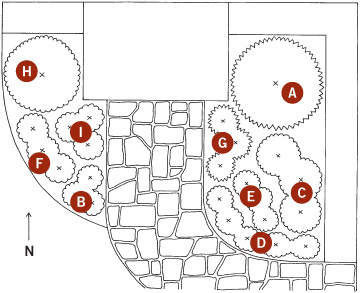
A Abelia × grandiflora ‘Little Richard’ (1 plant)
B Allium ‘Blue Twister’ (3 plants)
C Calamagrostis × acutiflora ‘Avalanche’ (3 plants)
D Dianthus ‘Firewitch’ (3 plants)
E Echinacea ‘Fragrant Angel’ (3 plants)
F Echinacea ‘Matthew Saul’ (3 plants)
G Lavandula angustifolia ‘Buena Vista’ (3 plants)
H Perovskia ‘Filigran’ (1 plant)
I Sedum rupestre ‘Angelina’ (3 plants)
‘Little Richard’
‘LITTLE RICHARD’ GLOSSY ABELIA
Tiny, glossy leaves are reddish when new, turning rich green in summer and then deep purple-red in fall and lasting well into winter; fragrant white flowers and pink calyces from late spring into early fall. About 3' tall × 3'—4' wide. Full sun to partial shade; average, well-drained soil. Zones 6—9.
Suggested alternative: ‘Rose Creek’.
‘BLUE TWISTER’ CORKSCREW CHIVES
Slender, blue-green twisted foliage through the growing season; clusters of pink flowers in mid- to late summer (into early fall with deadheading). About 1' tall and wide. Full sun to light shade; average, well-drained soil. Zones 3—8. Suggested alternative: Allium senescens var. glaucum (intensity of blue leaf color can vary).
Calamagrostis × acutiflora ‘Karl Foerster’
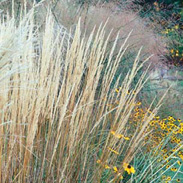
‘AVALANCHE’ FEATHER REED GRASS
Very slender, white-centered, green-edged blades through the growing season, turning tan in winter; pinkish green flower plumes appear in midsummer, turning tan and lasting into winter. 4'—5' tall × 2'—3' wide. Full sun to light shade; average, well-drained soil. Zones 4—8. Suggested alternative: ‘Overdam’ (green leaves with white edges) or ‘Karl Foerster’ (solid green leaves).
‘FIREWITCH’ PINK
Slender, blue-gray leaves look good all year long; deep pink flowers bloom most abundantly in late spring to early summer; can repeat through rest of growing season if deadheaded. About 8" tall × 18" wide. Full sun; average, well-drained soil. Zones 3—8.
Suggested alternative: ‘Bath’s Pink’ (lighter pink flowers).
‘FRAGRANT ANGEL’ CONEFLOWER
Deep green foliage through the growing season; fragrant, daisylike blooms with golden orange centers and white petals from early summer to early fall, developing into dark seed heads that last well into winter. 30"—40" tall × about 18" wide. Full sun to light shade; average, well-drained soil. Zones 3—9.
Suggested alternative: ‘Primadonna White’.
HARVEST MOON CONEFLOWER
Deep green foliage through the growing season; scented, daisy-form flowers with golden orange centers and golden yellow petals from early summer to early fall, followed by long-lasting dark seed heads that add interest well into winter. About 3' tall × about 18" wide. Full sun; average, well-drained soil. Zones 4—9. Suggested alternative: Another coneflower in same color range, such as ‘Sunrise’ (paler yellow) or ‘Sunset’ (more distinctly orange).
‘BUENA VISTA’ ENGLISH LAVENDER
Narrow, fragrant, grayish green leaves; spikes of purple-blue flowers mostly in late spring to early summer but often again in fall. 18"—24" tall and wide. Full sun; average, well-drained soil. Zones 5—9. Suggested alternative: Another cultivar of English lavender, such as ‘Hidcote Superior’ or ‘Royal Velvet’ (although neither is as likely to bloom again in fall).
‘Filigran’
‘FILIGRAN’ RUSSIAN SAGE
Lacy gray leaves through the growing season; airy clusters of small blue flowers from mid- or late summer into fall on whitish stems that remain attractive through the winter. About 3' tall and wide. Full sun; average, well-drained soil. Zones 4—9. Suggested alternative: ‘Little Spire’.
Sedum rupestre ‘Angelina’
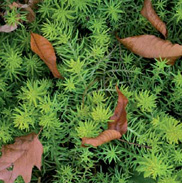
Sedum rupestre ‘Angelina’
Ever-present bright yellow foliage that takes on orange tones in winter sun; yellow summer flowers. About 6" tall × 12"— 18" wide. Full sun to partial shade; average, well-drained soil. Zones 3—9. Suggested alternative: S. spurium ‘John Creech’ (green foliage and pink flowers).
When you’re planning a garden around an entryway, keep in mind that pumpkins, gourds, and other seasonal accents can help bring the autumn show right up to your doorstep. In other seasons, you might use container plantings instead: heat-loving annuals for summer and potted bulbs for early color. Sure, you could buy pots of already-in-bloom bulbs in spring, but it’s easy to start them yourself in autumn. Simply add some extra bulbs to your order for fall planting, then pot them up when you plant the rest in the ground. Plastic pots work well, because you don’t have to worry about them cracking during cold weather. You can always slip them into prettier-looking pots for display in spring.
Starting single-layer pots. For the best show, start with large, firm bulbs that are uniform in size, so they’ll bloom all at the same time. Pots that are 6 to 8 inches in diameter will hold about a dozen small bulbs or six larger bulbs; 10- to 12-inch-diameter pots can hold around 18 small bulbs or about a dozen daffodils or tulips. Add at least 1 inch of moistened potting mix to the bottom of the pot, then set in your bulbs so they are almost touching. Fill in with more potting mix to within ½ to ¼ inch of the top.
Layering bulbs in a pot. For an extended show in a limited space, combine two or more types of spring bulbs in each pot. Start as you would for single-layer pots above, then set in the largest bulbs, covering them with just enough potting mix to cover. Repeat with smaller bulbs, such as dwarf daffodils, and finally with squills, reticulated iris (Iris reticulata), or other tiny bulbs if there is enough room. Make sure you can cover the top layer with at least 1 inch of potting mix.
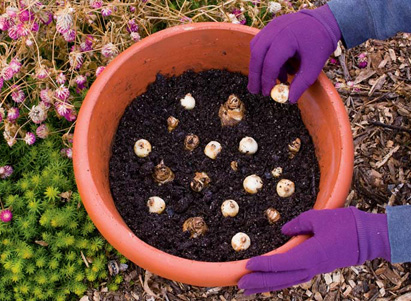
Layering bulbs in a pot.
Post-planting care for potted bulbs. Water thoroughly, then set the potted bulbs into a cool spot (ideally 33° to 40°F). Indoors, use a refrigerator or unheated porch or garage; outside, group them against the house foundation or bury them in the ground. For your outdoor display, move them to their decorative porch containers in late winter or early spring. (For earlier indoor bloom, bring them into a warmer, bright area after 10 to 12 weeks.) After bloom, move the pots to a less visible place, keep watering, and feed every two weeks with liquid fertilizer until the leaves start to turn brown. Plant the dormant bulbs in your garden for rebloom next year.
Do you have a low spot in your yard where water tends to puddle for a day or two after a heavy rain or a frequently soggy site where water flows out of a downspout from your home’s gutters? While these sites can stay distinctly wet during the rainy seasons, they may dry out quickly when rainfall is less abundant: a tough combination for many traditional border flowers, but no problem for a number of tougher perennials and grasses. Many of these no-nonsense plants have evolved to deal with these very conditions in their natural habitats, so they easily make the transition to similar sites in our home landscapes.
If you’re going to invest time and energy in designing and planting a garden, it just makes sense to make your plants work as hard as you do! This design is based on perennials that can readily adapt to alternating wet and dry conditions, contribute significant interest for a good part of the growing season, and supply an abundance of nectar and seeds to attract a bounty of songbirds, butterflies, and maybe even hummingbirds. Many of the plants tend to either spread out by creeping roots or fill a lot of aboveground space with their bushy top growth, so we’ve included just a few favorites in this design. Other options abound, including many other fall-flowering ornamental grasses, asters and other daisy-form flowers, along with fruiting shrubs, such as viburnums and deciduous hollies (Ilex).
This planting plan is designed to fit in the corner of a yard, but you could easily change the shape or dimensions to fit your site. Even though these plants can tolerate dry spells once they’ve had a few years to get their roots established, it’s a good idea to water them regularly during dry spells through at least their first growing season. Once they’re established, maintenance is mostly a matter of cutting down all of the plants to ground level in early spring. Keep in mind that the birds are likely to miss at least some of the seeds as they feed, so you’ll also want to watch for self-sown seedlings and remove them to prevent the plants from getting too crowded.
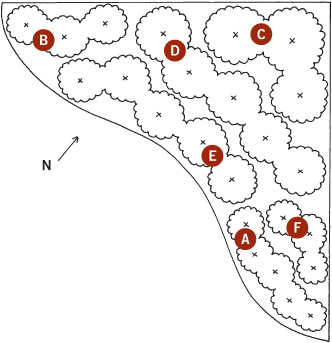
A Chelone lyonii ‘Hot Lips’ (5 plants)
B Eupatorium dubium ‘Little Joe’ (3 plants)
C Helianthus ‘Lemon Queen’ (3 plants)
D Panicum virgatum ‘Shenandoah’ (5 plants)
E Rudbeckia fulgida var. fulgida (5 plants)
F Vernonia noveboracensis (3 plants)
‘HOT LIPS’ TURTLEHEAD
Bronzy new growth that turns deep green for summer and fall; spikes of rosy pink flowers in late summer and early fall. 2'—3' tall and wide. Full sun to partial shade; evenly moist soil. Zones 5–8. Suggested alternative: C. lyonii or C. obliqua; Physostegia virginiana ‘Vivid’ (spreads even more quickly by creeping roots).
‘LITTLE JOE’ JOE-PYE WEED
Narrow, deep green leaves in spring and summer, darkening to reddish purple in mid- to late fall; domed clusters of rosy pink flowers in late summer to early fall, holding their form into winter. 4'—5' tall × 12"—18" wide. Full sun to partial shade; moist but well-drained soil. Zones 4—8. Suggested alternative: E. purpureum ‘Little Red’; E. maculatum ‘Purple Bush’.
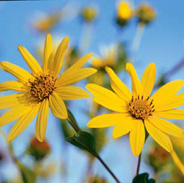
Helianthus ‘Lemon Queen’
‘LEMON QUEEN’ PERENNIAL SUNFLOWER
Deep green spring and summer foliage, turning shades of deep red or yellow in autumn; clear yellow daisies in late summer and early fall. 6'—8' tall × 2'—3' wide. Full sun to light shade; average to moist but well-drained soil. Zones 4—9.
Suggested alternative: H. angustifolius ‘Mellow Yellow’ (lighter yellow fl owers on 8'–10'-foot-tall plants).
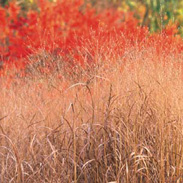
Panicum virgatum ‘Shenandoah’
Panicum virgatum ‘Shenandoah’
‘SHENANDOAH’ SWITCHGRASS
Slender green blades tipped with red by early summer, turning solid burgundy in fall before drying to tan; stands through the winter; airy red-tinged flower plumes in fall that also last into winter. About 4' tall × 18"—24" wide. Full sun to light shade; average to moist but well-drained soil. Zones 4—9.
Suggested alternative: ‘Rotstrahlbusch’ (similar in height but doesn’t take on reddish tones until late summer).
ORANGE CONEFLOWER
Deep green leaves through the growing season (basal clumps are usually evergreen); dark-centered, golden yellow daisies in late summer and early fall, aging into dark seed heads that last through most of the winter. About 30" tall × 18"— 24" wide. Full sun to light shade; average to moist but well-drained soil. Zones 4—9. Suggested alternative: R. fulgida var. sullivantii ‘Goldsturm’ (blooms earlier—from mid- to late summer — but has similar seed heads).
NEW YORK IRONWEED
Narrow, deep green leaves from spring through fall; airy clusters of deep reddish purple flowers in late summer to early or mid-fall. Usually 5'—7' tall (shorter if cut back by half in midsummer) × 18"—24" wide. Full sun to light shade; average to moist but well-drained soil. Zones 5—9. Suggested alternative: Another species of ironweed, such as V. altissima or V. fasciculata; another Eupatorium purpureum or E. maculatum selection.
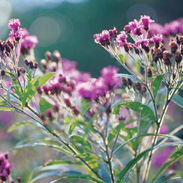
Vernonia noveboracensis
Tall-growing fall flowers are great for in-your-face color, but they’re no fun if their stems end up flopping into the mud. You might plan ahead and stake or cut back clumps earlier in the season, or you might take the chance that they make it into fall without sprawling. If you try the latter approach and lose the gamble, all is not lost; there are a couple of propping-up options to consider. Whichever you choose, try to get them in place before the plants fall over completely, because it’s far easier to prop up a leaner than it is to straighten up fully sprawled stems. (The results will look more natural, too.)
Stake ’em up! The traditional pairing of stakes and string is one solution for supporting sprawlers — particularly those with tall stems. The stakes need to be very sturdy, since full-grown stems can be very heavy: ½- to 1-inch-wide wooden stakes that are about three-quarters of the plant’s height should do the trick. Pound three to five stakes into the ground around the clump a few inches away from the crown, until they are 8 to 12 inches deep. Use twine or yarn to corral the stems between the stakes, running it loosely around the outside of the clump as well as back and forth among the stems. Here’s a hint: If you paint the stakes black or dark brown and use yarn of the same color, you’ll hardly notice them!
Brush for bushy plants. When lower, bushy plants flop open, you can often save the day by propping them up with twiggy branches. Raid your brush pile for short but well-branched shoots left over from last fall’s or spring’s pruning; pieces about 18 inches long are usually ideal. Carefully push several of them 6 to 8 inches into the ground around the clump. Lift up the perennial’s stems with your fingers, then let them go a few at a time so the leaves and flowers are caught by the twigs. With some primping, you should be able to get all the stems supported in a fairly natural-looking mound. Trim off any twiggy tips that stick up over the blooms.
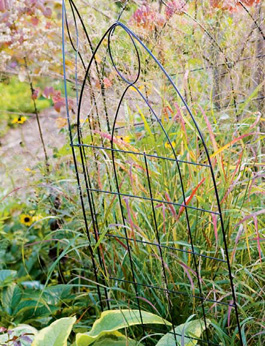
Using metal trellising as a prop.
Make the most of your mis-stakes. Sometimes, the best solution for supporting flopping stems is the most obvious one — literally! Instead of trying to stake subtly, use some decorative object to prop up leaning stems. Wooden obelisks, short sections of picket or ironwork fencing, and even interesting bits of rusted metal can serve as attractive garden accents and functional support systems at the same time. You might even decide you like the effect and leave them in place permanently. Or, stockpile a few of these mobile “props” as you find them, then move them around your garden as needed when leaners threaten to become sprawlers.
Bright shades of red, orange, yellow, and purple are the basis of nature’s fall color palette, and they’re a natural choice for celebrating autumn in a garden setting, too. These rich colors are useful for adding drama to small spaces, but they’re particularly striking in larger spaces, especially when you place them against a background of bright or dark greens, such as an evergreen hedge. If you’re not sure you’d enjoy such color intensity all through the growing season, you can base your plantings on softer shades for spring and summer, then toss in some bright blooms and colorful fall foliage to end the show with a bang.
Side yards are an ideal place to experiment with color schemes that you’re not sure you want to try in a more highly visible spot. Adding a fence and gate helps to create a sense of enclosure and privacy for your backyard while providing several exciting garden opportunities: You can plant on the side facing the street, the side facing the backyard, or both sides. Including an arbor over the gate provides a perfect support for a colorful vine, too.
This design is packed with a variety of hot-colored tender perennials and annuals for shocking summer and fall color. You won’t want to set out these heat-loving plants until all chance of frost has passed, but you can get a jump on the growing season by starting the annuals and bulbs indoors a few weeks earlier. They’ll take several weeks to fill in after planting, but with plenty of heat and water, they’ll soon create a lush display of colorful flowers and foliage. After frost, you can dig up the cannas and dahlias for indoor storage in a frost-free place, then pull out the rest of the frost-killed plants.
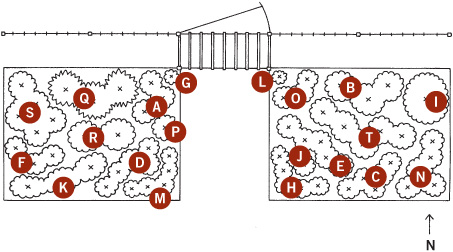
A Canna ‘Minerva’ (3 plants)
B Canna ‘Pretoria’ (3 plants)
C Capsicum annuum ‘Black Pearl’ (5 plants)
D Celosia argentea var. cristata Plumosa Group ‘Fresh Look Orange’ (5 plants)
E Celosia argentea var. cristata Plumosa Group ‘Fresh Look Red’ (5 plants)
F Dahlia ‘Bishop of Llandaff’ (3 plants)
G Lablab purpureus ‘Ruby Moon’ (1 plant)
H Gomphrena globosa ‘Rainbow Purple’ (5 plants)
I Hibiscus acetosella ‘Maple Sugar’ (1 plant)
J Ipomoea batatas ‘Margarita’ (1 plant)
K Lantana ‘New Gold’ (3 plants)
L Mina lobata (1 plant)
M Nicotiana ‘Perfume Deep Purple’ (5 plants)
N Nicotiana langsdorffii (5 plants)
O Pennisetum glaucum ‘Purple Majesty’ (3 plants)
P Pennisetum setaceum ‘Rubrum’ (1 plant)
Q Ricinus communis ‘Carmencita’ (3 plants)
R Salvia ‘Purple Majesty’ (2 plants)
S Tithonia rotundifolia ‘Fiesta del Sol’ (5 plants)
T Zinnia elegans ‘Benary’s Giant Purple’ (5 plants)
A Spectacular Side-yard Garden
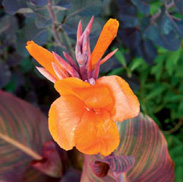
Canna Tropicanna
‘MINERVA’ CANNA
Large, broad green leaves with creamy white pinstripes through the growing season; yellow flowers from midsummer to frost. 4'—6' tall × 12"—18" wide. Full sun to light shade; average to moist but well-drained soil. Zones 8—10; grow as an annual elsewhere. Also sold as ‘Nirvana’ or ‘Striped Beauty’.
Suggested alternative: Another variegated canna, such as ‘Pretoria’ or Tropicanna (‘Phaison’).
Canna ‘Pretoria’
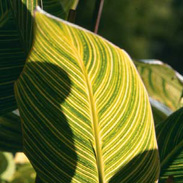
Canna ‘Pretoria’
‘PRETORIA’ CANNA
Large, broad green leaves striped with yellow and rimmed with red through the growing season; large orange flowers from midsummer to frost. About 6' tall × 12"—18" wide. Full sun to light shade; average to moist but well-drained soil. Zones 8—10; grow as an annual elsewhere. Also sold as ‘Bengal Tiger’.
Suggested alternative: Another variegated canna with orange flowers, such as the slightly shorter Tropicanna Gold (‘Mactro’).
Capsicum annuum ‘Black Pearl’
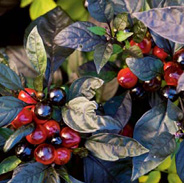
‘BLACK PEARL’ PEPPER
Oblong, near-black leaves through the frost-free season; small purple flowers through summer, followed by rounded near-black fruits that ripen to bright red in late summer and fall. 18"—24" tall × about 1' wide. Full sun; average, well-drained soil. Zones 9—11; grow as an annual elsewhere.
Suggested alternative: Other purple-leaved peppers in the same height range, such as ‘Little Nubian’, ‘Peruvian Purple’, and ‘Pretty in Purple’.
‘FRESH LOOK ORANGE’ CELOSIA Medium-sized, medium green leaves through the growing season; dense plumes of bright orange flowers from midsummer to frost. 12"—18" tall × about 8" wide. Full sun; average, well-drained soil. Annual. Suggested alternative: Another celosia with orange plumes, such as ‘Apricot Brandy’ or ‘Castle Orange’.
‘FRESH LOOK RED’ CELOSIA
Medium-sized, medium green leaves through the growing season; dense plumes of rich red flowers from midsummer to frost. 12"—18" tall × about 8" wide. Full sun; average, well-drained soil. Annual. Suggested alternative: Another celosia with red plumes, such as ‘Castle Scarlet’.
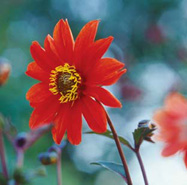
Dahlia ‘Bishop of Llandaff’
Dahlia ‘Bishop of Llandaff
‘BISHOP OF LLANDAFF’ DAHLIA
Lacy, deep purple to near-black foliage through the growing season; single to semidouble scarlet flowers from midsummer to frost. About 3' tall × about 1' wide. Full sun to light shade; average, well-drained soil. Zones 8—10; grow as an annual elsewhere. Suggested alternative: Another dark-leaved dahlia in the 2'- to 3'-tall range, such as deep red ‘Bishop of Auckland’ or ‘Bednall Beauty’.
‘RAINBOW PURPLE’ GLOBE AMARANTH
Small, oblong green leaves through the growing season; globelike, magenta-purple flower heads from early summer to frost. About 18" tall × 8"—12" wide. Full sun; average, well-drained soil. Annual. Suggested alternative: ‘Buddy Purple’ (about 8'' tall) or another purple-fl owered globe amaranth.
Hibiscus acetosella ‘Maple Sugar’
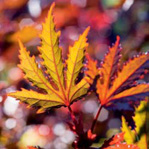
‘MAPLE SUGAR’ AFRICAN ROSE MALLOW
Deeply lobed, deep red leaves through the growing season; red to pink flowers in late fall to winter where the plants are hardy. Usually 4'—6' tall × about 2' wide. Full sun to light shade; average to moist but well-drained soil. Zones 8—11; grow as an annual elsewhere. Also sold as ‘Jungle Red’. Suggested alternative: H. acetosella ‘Red Shield’ (also known as ‘Coppertone’); a red-leaved annual amaranth (Amaranthus), such as ‘Hopi Red Dye’.
‘MARGARITA’ SWEET POTATO VINE
Heart-shaped, bright yellow leaves on long, trailing stems through the growing season. About 6" tall × 6'—8' wide. Full sun to light shade; average to moist but well-drained soil. Zones 10—11; grow as an annual elsewhere.
Suggested alternative: ‘Sweet Caroline Light Green’ (same color but with lobed leaves on less-vigorous vines).
Ipomoea batatas ‘Margarita’
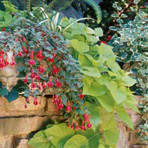
HYACINTH BEAN
Three-part, deep green leaves on twining stems through the growing season; clusters of bright purplish pink flowers from midsummer to frost, followed by deep reddish purple pods in late summer and fall. 10'—20' tall (depending on the size of the support). Full sun; average, well-drained soil. Zones 10—11; grow as an annual elsewhere. Also sold as Dolichos lablab. Suggested alternative: L. purpureus (the species may have lighter pink or even whitish flowers).
‘NEW GOLD’ LANTANA
Rough, rich green leaves through the growing season; clusters of bright yellow flowers from late spring or early summer to frost. 1'—2' tall × 2'—3' wide. Full sun; average, well-drained soil. Zones 8—11; grow as an annual elsewhere. Suggested alternative: Another compact, bright yellow lantana, such as ‘Landmark Gold’ or ‘Lucky Pot of Gold’; melampodium (Melampodium paludosum).
SPANISH FLAG
Lobed, deep green leaves on twining stems through the growing season; one-sided spikes of red buds that open to orange and fade to yellow from midsummer to frost. 8'—12' tall (depending on the height of the support). Full sun to light shade; average, well-drained soil. Annual. Also sold as Ipomoea lobata.
Suggested alternative: Chilean glory vine (Eccremocarpus scaber); cardinal climber (Ipomoea × multifida).
‘PERFUME DEEP PURPLE’ FLOWERING TOBACCO
Bright green, roughly spoon-shaped leaves through the growing season; trumpet-shaped, deep purple, fragrant flowers from early summer to frost. 12"—18" tall × about 8" wide. Full sun to light shade; average to moist but well-drained soil. Zones 10 and 11; grow as an annual elsewhere. Suggested alternative: A purple-flowered angelonia, such as ‘AngelMist Purple Improved’.
FLOWERING TOBACCO
Bright green, roughly spoon-shaped leaves through the growing season; bell-shaped, bright yellowish green flowers from midsummer to frost. 2'—4' tall × 8"—12" wide. Full sun to light shade; average to moist but well-drained soil. Grow as an annual. Suggested alternative: N. alata ‘Lime Green’ (larger, lighter green flowers).
‘PURPLE MAJESTY’ MILLET
Long, straplike, deep purple leaves through the frost-free season; dense, spikelike clusters of cream-colored flowers in mid- to late summer mature into deep purple seed heads in late summer and fall. 4'—5' tall × 12"—18" wide. Full sun; average, well-drained soil. Zones 9—11; grow as an annual elsewhere.
Suggested alternative: P. glaucum ‘Purple Baron’ or ‘Jester’ (3-4' tall); P. macrostachyum ‘Burgundy Giant’ (about 6' tall).
Pennisetum setaceum ‘Rubrum’
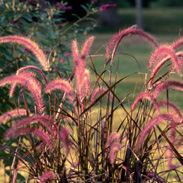
PURPLE FOUNTAIN GRASS
Slender, glossy, deep purplish red blades all through the frost-free season; brushy tan flower spikes heavily blushed with pink to burgundy from mid- or late summer to frost. 4'—5' tall × 12"—18" wide. Full sun; average to moist but well-drained soil. Zones 10 and 11; grow as an annual elsewhere.
Suggested alternative: P. macrostachyum ‘Burgundy Giant’; a dark-leaved Phormium selection, such as ‘Platt’s Black’ or ‘Dark Delight’.
Ricinus communis ‘Carmencita’
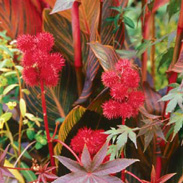
Ricinus communis ‘Carmencita’
‘CARMENCITA’ CASTOR BEAN
Large, lobed, deep red leaves through the frost-free season; clusters of pinkish female flowers over cream-colored male flowers from midsummer into fall, with the females maturing into bright red, spiny seed capsules from late summer to frost. 6'—8' tall × about 2' wide. Full sun to light shade; average to moist but well-drained soil. Zones 9—11; grow as an annual elsewhere. Suggested alternative: Another dark-leaved castor bean, such as ‘Carmencita Pink’ (with bright pink seedpods) or ‘Dwarf Red Spire’ (slightly shorter).
‘PURPLE MAJESTY’ SALVIA
Deeply veined, bright green leaves through the growing season; spikes of rich purple flowers from early or midsummer to frost. 4'—6' tall × about 3' wide. Full sun to light shade; average, well-drained soil. Zones 7—10; grow as an annual elsewhere. Suggested alternative: S. guaranitica ‘Black and Blue’ (blue flowers) or S. ‘Indigo Spires’ (deep purple-blue flowers).
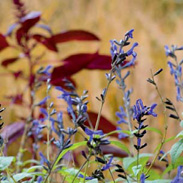
Salvia guaranitica ‘Black and Blue’
Tithonia rotundifolia ‘Fiesta del Sol’
‘FIESTA DEL SOL’ MEXICAN SUNFLOWER
Lobed, velvety, deep green leaves through the growing season; bright orange daisies from midsummer to frost. 3'—4' tall × 2'—3' wide. Full sun; average, well-drained soil. Annual.
Suggested alternative: T. rotundifolia ‘Torch’ (4'-6' tall); an orange-flowered zinnia, such as ‘Benary’s Giant Orange’ (about 4' tall).
When you create gardens that include perennials not hardy in your area, figuring out exactly when to bring those tender plants indoors is always a tough call. You don’t want them exposed to too much cold, but you also don’t want to cut short your outdoor display by bringing them in earlier than is necessary. Planning can make the whole process go more smoothly, so in early fall, make a list of what you want to bring inside. Start digging up a few of those plants at a time when nighttime temperatures start dipping into the 40s, or wait until frost is predicted and spend a whole day gathering all the plants on your list and hauling them indoors. The choice is yours!
Planning at planting time. The way you planted your tender perennials in spring has an influence on how easy your fall digging-up sessions will be. Scattering the plants throughout your beds and borders means that when you remove them in fall, the remaining annuals and hardy perennials will still be there to carry on the show until at least the first frost. On the downside, it’s easy to overlook the tenders when they’re mixed in with other plants, and you might forget to dig some until it’s too late. Combining them into “blocks” within a border, or keeping them in only one part of your yard, makes them much easier to find when it’s time to bring them indoors (a big plus when you’ve waited until the last minute to dig them).
Post-digging options. Once you dig them up, what do you do with them? It depends on whether they’ll keep growing through the winter or instead stay dormant until spring. Those that grow from specialized structures such as rhizomes, tuberous roots, bulbs, and corms—including cannas, dahlias, and gladiolus —typically survive winter in the dormant state; lift them from the soil with a spading fork, cut back the top growth, and place them into labeled bags or boxes for winter storage. To overwinter other plants, you’ll need to either take cuttings or dig and pot up the clumps. If the plants are very large, cut them back by half or more before bringing their pots indoors; they’ll take up less space and look better when they resprout.
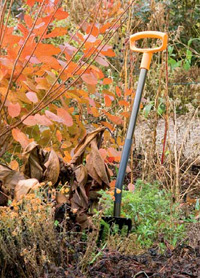
Digging up tender perennials for overwintering.
Going mobile. Of course, the easiest way to bring tender plants indoors is to keep them in individual pots, so you simply carry them indoors when cool nights threaten. In return for this convenience, though, you’ll have to water and fertilize them much more often during the growing season than you would if they were growing in the ground. Before bringing potted plants indoors for the winter, check them carefully for signs of aphids and other pests and spray with insecticidal soap if needed. And don’t be surprised if the plants drop some of their leaves when you bring them in; that’s a common reaction as they adapt to the warmer, drier air and lower light levels inside your home.
If your color preferences run more toward soft pinks and blues than brilliant reds and oranges, there are plenty of terrific fall plants for you to choose from. In fact, autumn tends to bring out the best in pastel-colored flowers: The less-intense light shows off their delicate hues, and the cooler temperatures help them last far longer than they would under scorching summer sun. To complement the abundance of light-colored blooms, look for companions that have pink, white, or yellow fall fruits — such as snowberries (Symphoricarpos) and some deciduous hollies (like Ilex verticillata ‘Winter Gold’) — and softer shades of the usual bright fall foliage colors.
In any season, light-colored flowers show off beautifully in small spaces, but their pale hues often don’t make much of a visual impact when you see them at a distance, particularly if the blooms themselves are on the small side. Planting them in masses is a great way to give them more of a presence, and has the added benefit of making maintenance much easier.
Based on a very simple combination of lines and arcs, this relatively small island bed design would fit well into a fairly narrow space, such as a side yard. By increasing the size of each planting area within the design, it would be easy to expand this into a substantial bed to fill a much larger space. Although this design provides some color interest in early summer from the Bowman’s root and catmint, it’s really at its best from late summer through fall for bloom and foliage color. As a bonus, it includes many attractive seed heads that last through most or all of the winter. Give the whole garden a thorough cleanup by cutting everything just above ground level in early spring, and shear back the catmint by about half in midsummer, to enjoy a beautiful show of late-season pastels every year.
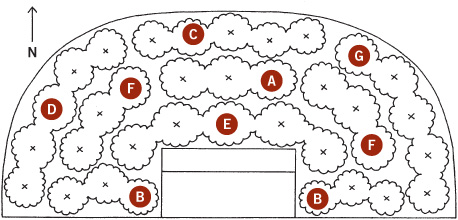
A Anemone × hybrida ‘Party Dress’ (3 plants)
B Aster ‘Wood’s Pink’ (6 plants)
C Aster laevis ‘Bluebird’ (5 plants)
D Gillenia trifoliata (5 plants)
E Nepeta ‘Six Hills Giant’ (5 plants)
F Pennisetum orientale ‘Karley Rose’ (6 plants)
G Physostegia virginiana ‘Miss Manners’ (5 plants)
‘PARTY DRESS’ JAPANESE ANEMONE
Deep green, three-part, lobed leaves from spring through fall; large, double pink flowers with yellow centers in late summer and early fall. 3'—4' tall × 2'—3' wide. Full sun to partial shade; average to moist but well-drained soil. Zones 4—8. Suggested alternative: Another pink-flowered Japanese anemone, such as semi-double ‘Bressingham Glow’, ‘Lady Gilmore’, or ‘Queen Charlotte’.
‘WOOD’S PINK’ ASTER
Short, narrow green leaves from spring through fall; small, clear pink, yellow-centered daisies from late summer to mid-fall. 12"—18" tall and wide. Full sun; average to moist but well-drained soil. Zones 4—8.
Suggested alternative: Another compact, pastel-flowered aster, such as ‘Wood’s Light Blue’ or purple-blue ‘Professor Kippenburg’.
‘BLUEBIRD’ SMOOTH ASTER
Short, narrow green leaves from spring through fall; small, purple-blue, yellow-centered daisies from early to mid-fall. 3'—4' tall × about 18" wide. Full sun; average, well-drained soil. Zones 3—8.
Suggested alternative: Another purple-blue aster in the same height range, such as A. oblongifolius ‘October Skies’ or ‘Raydon’s Favorite’.
BOWMAN’S ROOT
Toothed, three-part, green leaves in spring and summer, turning maroon in fall; tiny white flowers in late spring and early summer, maturing into deep red seed capsules that provide fall and winter interest. About 3' tall and wide. Full sun to partial shade; average to moist but well-drained soil. Zones 4—8. Also sold as Porteranthus trifoliatus.
Suggested alternative: Gillenia stipulatus; Gaura lindheimeri.
‘SIX HILLS GIANT’ CATMINT
Small, aromatic, gray-green leaves from early spring through fall; loose spikes of small purple-blue flowers in spring into summer, with repeat bloom in late summer and fall if sheared back by about half in midsummer. About 3' tall × 2'—3' wide. Full sun to partial shade; average, well-drained soil. Zones 4—8.
Suggested alternative: Another blue-flowered catmint, such as ‘Walker’s Low’ or N. sibirica ‘Souvenir d’Andre Chaudron’; ‘Little Spire’ Russian sage (Perovskia).
‘KARLEY ROSE’ FOUNTAIN GRASS
Long, slender green leaves from spring through fall; fuzzy, rosy pink flower spikes from early or midsummer through fall. 3' tall × 1' wide. Full sun; average, well-drained soil. Zones 5–8. Suggested alternative: P. orientale ‘Tall Tails’ (about 4' tall); ‘Heavy Metal’ switchgrass (Panicum virgatum); frost grass (Spodiopogon sibiricus).
‘MISS MANNERS’ OBEDIENT PLANT
Short, narrow, deep green leaves through spring and summer, turning yellowish in fall; spikes of white flowers from midsummer to early fall with regular deadheading. 2'—3' tall × 12"—18" wide. Full sun to partial shade; average to moist but well-drained soil. Zones 3—9.
Suggested alternative: ‘Whirling Butterflies’ gaura (Gaura lindheimeri).
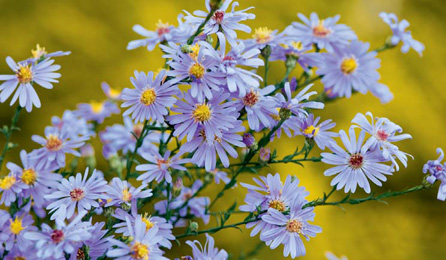
Aster laevis ‘Bluebird’
Removing faded flowers—a technique that gardeners commonly call deadheading—isn’t much of an issue with most plants that wait until fall to bloom because you deal with the spent flower stems when you do your routine late-fall or early-spring cleanup. But if you’re trying to get summer-bloomers, such as catmints (Nepeta) and obedient plant (Physostegia virginiana), to extend their display into autumn, deadheading can be a very handy trick to try.
So, how does it work? Basically, deadheading stops a plant from producing seeds. Besides eliminating the problem of unwanted seedlings, interfering with seed production can also encourage the plant to send out more flowers in an effort to make seed from those blooms. By removing individual blossoms or clusters, you may extend the bloom season for several weeks. Or, you can shear off all the spent flowers at once and perhaps get a whole new crop of flowers in return. That means two or even three bloom cycles each year instead of just one! Granted, the blossoms often aren’t quite as abundant in these later flushes, and their stems are usually shorter, but they’re still welcome in the fall garden. Even if the plant doesn’t flower again, it will likely produce a clump of fresh, great-looking foliage that adds interest to your autumn beds and borders.
Despite all of the benefits that deadheading can provide, there are some times when you don’t want to use it. If you hope to collect the seeds from a particular plant, for instance, removing the spent flowers is counterproductive. Deadheading also eliminates the many wonderful seed heads and berries that can extend your garden’s beauty well into the winter months. So if you’re growing perennials with interesting winter silhouettes, such as bee balms (Monarda) and asters, or if you want lots of seeds and berries to attract winter birds, it’s smart to think twice about what you are deadheading, and why. To get the best of both worlds (long bloom season and showy seed heads), experiment with deadheading for just a few weeks, then leave the rest of the flowers to mature on the plants.
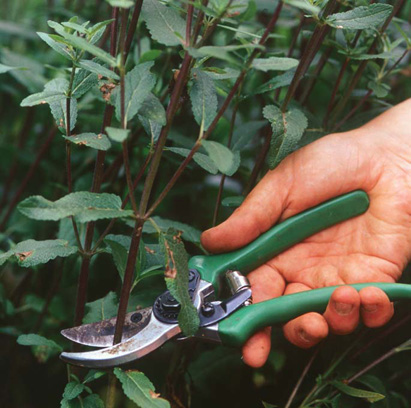
Removing entire flower stem to encourage rebloom.
Fall gardens aren’t just about showy flowers and colorful foliage, of course; they can be quite productive, too. The combination of warm soil and cool air provides ideal growing conditions for many cool-season flowers, vegetables, and herbs, as well as for late-summer sowings of fast-maturing flowers and veggie crops. Basil, peppers, and other traditional summer edibles continue into fall; kales, chard, and other cold-tolerant leafy crops extend the harvest into winter, so you can enjoy a wide range of flavors over a long period even in a small garden space.
Mixing vegetables, herbs, and flowers together is a great way to create plantings as useful as they are pretty. With careful planning, you can enjoy two harvests a year from the same amount of space by pulling out tired spring crops, such as dill and lettuce, in midsummer and sowing again for a fall harvest.
This design features two small, narrow borders that flank a path leading out from a kitchen door. To increase your yields, consider adding a few container plantings by the door, too. Paving the area right outside the door, as well as the path between the beds, ensures firm, clean footing, so you can easily pop out for quick harvests without even having to slip on your shoes. While this garden is planned more for production than good looks, it does provide a significant amount of color all through the growing season, thanks to the attractive foliage as well as the abundance of brightly hued blooms that are both edible and useful for cutting. Harvest the spring-sown plants often to encourage them to keep growing and flowering, then pull out the annuals when they stop producing to make room for a new sowing in summer.
Most of these plants will keep producing through a few light frosts. The basil and peppers hate cold temperatures, but if you pot up a few plants and bring them indoors before the first frost, you can extend their production by at least several weeks. Remember: Avoid using pesticides on or near flowers, vegetables, and herbs that you plan to use for eating.
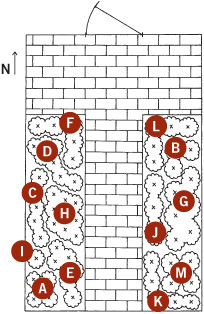
A Anethum graveolens ‘Fernleaf’ (5 plants)
B Beta vulgaris Cicla Group ‘Bright Yellow’ (3 plants)
C Brassica oleracea Acephala Group ‘Redbor’ (5 plants)
D Calendula officinalis (7 plants)
E Capsicum annuum ‘Sweet Pickle’ (6 plants)
F Fragaria vesca (5 plants)
G Helianthus annuus ‘Sundance Kid’ (6 plants)
H Lactuca sativa ‘Merlot’ (9 plants)
I Ocimum ‘Pesto Perpetuo’ (1 plant)
J Ocimum basilicum ‘Red Rubin’ (3 plants)
K Petroselinum crispum ‘Triple Curled’ (5 plants)
L Tropaeolum majus ‘Alaska Mix’ (5 plants)
M Viola hybrids (5 plants)
‘FERNLEAF’ DILL
Lacy, bright green, fragrant, and flavorful foliage for several weeks (in fall from an early to midsummer sowing); lacy clusters of tiny yellow flowers (in fall from an early to midsummer sowing). About 2' tall × 6"—8" wide. Full sun to light shade; average, well-drained soil. Annual. Suggested alternative: Another dill, such as ‘Dukat’ (3' tall); cilantro (Coriandrum sativum).
‘BRIGHT YELLOW’ SWISS CHARD
Broad, bright green leaves on thick bright yellow stalks through the growing season. 18"—24" tall × about 1' wide. Full sun to light shade; average to moist but well-drained soil. Annual. Suggested alternative: Another Swiss chard, such as red ‘Rhubarb’ or mixed-color ‘Bright Lights’.
Brassica oleracea Acephala Group ‘Redbor’
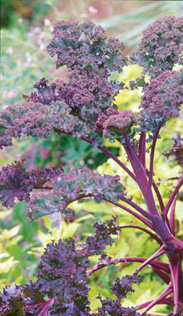
‘REDBOR’ KALE
Frilly edged, grayish to greenish purple leaves in spring and summer, turning deep purple in fall and lasting well into winter. 2'—3' tall × 12"—18" wide. Full sun to light shade; average to moist but well-drained soil. Annual.
Suggested alternative: Another kale, such as pink-stemmed, blue-leaved ‘Ragged Jack’ or blue-green ‘Lacinato’.
POT MARIGOLD
Bright green, roughly oval to lance-shaped leaves from spring through fall; single to double orange daisies from spring through fall with regular deadheading. 1'—2' tall × 6"—9" wide. Full sun; average, well-drained soil. Annual. Suggested alternative: Signet marigold (Tagetes tenuifolia; also sold as T. signata).
Calendula officinalis
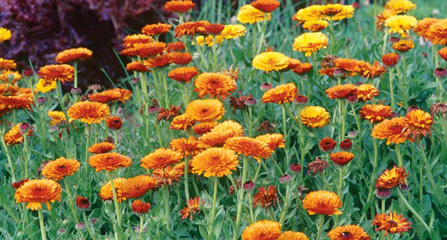
‘SWEET PICKLE’ PEPPER
Small, bright green leaves through the frost-free season; small, sweet, upright fruits that ripen through shades of yellow, orange, purple, and red from midsummer to frost. 12"—18" tall and wide. Full sun; average to moist but well-drained soil. Zone 10; grow as an annual elsewhere. Suggested alternative: Another compact, small-fruited pepper, such as sweet ‘Jingle Bells’ or medium-hot ‘Marbles’.
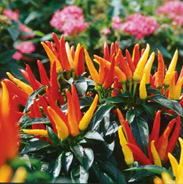
Capsicum annuum ‘Chilly Chili’
ALPINE STRAWBERRY
Toothed, three-part, green leaves from spring through fall (and through most or all of the winter in mild areas); small white flowers from late spring into fall, ripening into small, sweet, bright red fruits from early summer through fall. About 6" tall and wide. Full sun to partial shade; average to moist but well-drained soil. Zones 5–8.
Suggested alternative: Musk strawberry (F. moschata)— equally flavorful, but a creeper instead of a clump-former.
‘SUNDANCE KID’ SUNFLOWER
Rough, heart-shaped green leaves in summer and fall; semi-double flowers with dark centers and bright yellow outer petals in fall from mid- to late-summer sowing. About 2' tall × 6"—8" wide. Full sun; average, well-drained soil. Annual. Suggested alternative: Another dwarf sunflower, such as reddish ‘Double Dandy’ or mixed-color ‘Music Box’.
‘MERLOT’ LETTUCE
Crinkled, wavy-edged, deep red leaves in late summer and fall (from mid- to late-summer sowing). About 6" tall and wide. Full sun to partial shade; average to moist but well-drained soil. Annual. Suggested alternative: Another red or green-leaved lettuce, such as ‘Outredgeous’ or ‘Oakleaf’.
‘PESTO PERPETUO’ BASIL
Aromatic and flavorful, light green leaves edged with white through the frost-free season. 2'—3' tall × 1' wide. Full sun; average to moist but well-drained soil. Zone 10; grow as an annual elsewhere. Suggested alternative: Another kind of basil, such as lime, licorice, or cinnamon; rosemary (Rosmarinus officinalis).
‘RED RUBIN’ BASIL
Aromatic and flavorful, deep reddish purple leaves through the frost-free season; spikes of small pink flowers in summer and fall. 1'—2' tall × about 1' wide. Full sun; average to moist but well-drained soil. Annual.
Suggested alternative: Another purple- or green-leaved basil, such as dark ‘Osmin’ or tiny-leaved green bush basil.
Petroselinum crispum ‘Triple Curled’
‘TRIPLE CURLED’ PARSLEY
Deeply crinkled, bright green leaves from spring through fall, often lasting through the winter in mild areas. About 8" tall and wide. Full sun to partial shade; average to moist but well-drained soil. Grow as an annual.
Suggested alternative: Another curled-leaf parsley or flat-leaved Italian parsley.
‘ALASKA MIX’ NASTURTIUM
Circular, light green leaves randomly splashed with creamy white through the growing season; red, orange, or yellow flowers from summer to frost. 8"—12" tall and about as wide. Full sun to light shade; average to moist but well-drained soil. Annual.
Suggested alternative: Another nasturtium cultivar, such as ‘Tip Top Mahogany’ (with chartreuse leaves and deep red flowers) or ‘Empress of India’ (with red flowers and blue-green foliage).
Viola × wittrockiana ‘Baby Bingo’
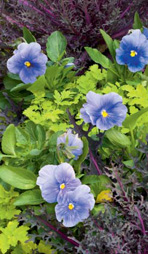
PANSIES
Small, bright green leaves through most of the year; flat-faced flowers in a wide range of colors and bicolors in fall and spring (and during mild winter weather too). 6"—8" tall and about as wide. Full sun to partial shade; average to moist but well-drained soil. Zones 4—9, but usually grown as an annual.
Suggested alternative: Another cool-season color accent sold in fall, such as edible or ornamental cabbage or kale (Brassica oleracea) or a chrysanthemum.
Whether you’re growing vegetables or flowers, frost isn’t exactly the life-or-death issue in fall that it is early in the growing season. In spring, it’s imperative to protect tender transplants when frost threatens; otherwise they can get damaged or killed outright, spoiling your display for the entire growing season. But by fall, many of those same plants are tough enough to withstand the identical amount of frost. And even if they don’t survive, at least you’ve had all season to enjoy them. Still, it’s natural to want to get the longest possible show from your beds and borders, so why not take a few minutes to protect frost-sensitive annuals and perennials when cold weather threatens? If you can get them through the first frost or two, you can often get at least another week or two of bloom — and maybe longer.
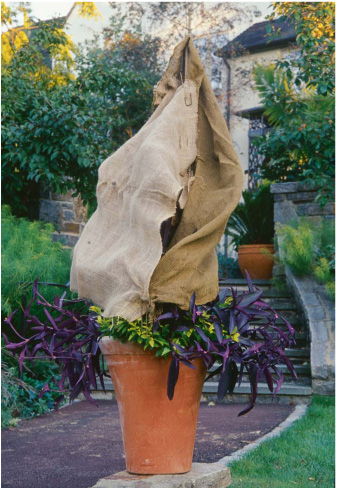
Temporary protection.
Collect your protectors. Often, you don’t get much warning when the first frost comes calling, so it’s smart to do some advance planning. First, keep in mind that moist soil will hold heat better, so keep your garden well watered. Pulling the mulch away from your tender plants can help, too; otherwise, the covering will prevent heat from radiating out of the soil and warming the air around the leaves and stems. Also, make a list of the plants you want to protect, then gather enough sheets, boxes, stakes, and other materials to cover them all, so you won’t have to hunt for them at the last minute. Plastic milk jugs and soda bottles are good to have on hand, too. (Filled with warm water and set out on chilly nights, they’re great for protecting special plants!)
Swing into action. When frost is imminent, start covering plants in mid- to late afternoon, when the soil is as warm as it’s going to get. Give top priority to gardens that are out in the open, particularly if they are on the top of a hill or at the bottom of a slope; save more sheltered spots for last. To protect individual plants, use upside-down boxes, pots, baskets, and buckets. To shield groups or large single plants, use old sheets, shower curtains, tarps, or floating row cover. If possible, keep the coverings from resting directly on the plants by draping them over stakes or ropes. Make sure they go completely to the ground and don’t gather them around the base of the plants; you want to include as much soil surface as you can underneath to trap the radiating heat. Move containers of tender plants next to walls, or set them under a bench or deck.
The day after. Ideally, you should wait until the frost has thawed the next morning, then remove the covers. What if you won’t be home then? If it’s still dark when you leave for work, it’s probably best to leave the covers in place until you get home; one day in the dark shouldn’t hurt the plants. If the sun is coming up when you leave, you can usually get away with removing the covers even if the frost hasn’t melted yet. Don’t despair if you forgot to cover a favorite plant; you may be able to save it by spraying it thoroughly with water before the sun hits the leaves. If it looks like only the outer tips have gotten frosted, trim off any damaged parts, and new growth may appear from the remaining stems.
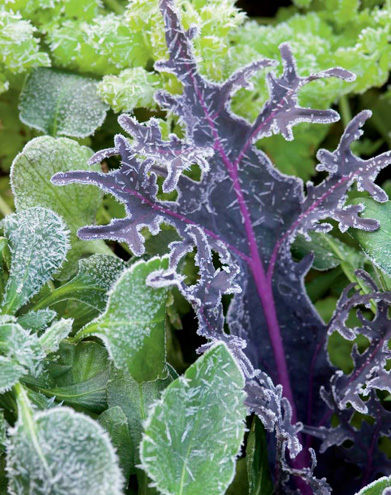
Some cold-hardy annuals, like this kale, can survive (and even thrive) after a touch of frost.
For many gardeners, one of the best aspects of fall gardening is the lack of stress. By this time of the year, the big projects are basically done, and daily maintenance isn’t nearly as critical, so there’s time to actually sit down and appreciate the beauty of the season. If you enjoy the laid-back mood of autumn, you’ll be happy to know that it’s possible to capture that feeling all through the gardening season. The secret is to concentrate on lowmaintenance ground covers, perennials, and shrubs that thrive with practically no input from you.
Plantings that hug house foundations are traditionally a collection of evergreen shrubs and ground covers — functional, perhaps, but not especially interesting. Replacing them with well-chosen deciduous shrubs and herbaceous plants that have multiseason interest gives you an ever-changing display of flowers, foliage, and fruits without making any more work for yourself in the process.
This design incorporates a number of other easy-care features as well, such as an access path between the back of the border and the house. (Besides preventing the plants from crowding too close to the house, reducing the need for pruning, it also keeps them out of the bone-dry zone that commonly forms under a roof overhang, thus minimizing the need for watering.) Within the border, using compact shrub cultivars practically eliminates pruning chores, while the low-growing, spreading perennials act like a living mulch to help to crowd out weeds. All that’s really needed is to trim the dead perennial stems close to the ground in spring; you might also choose to give the spirea a light trim after its first bloom to promote rebloom.
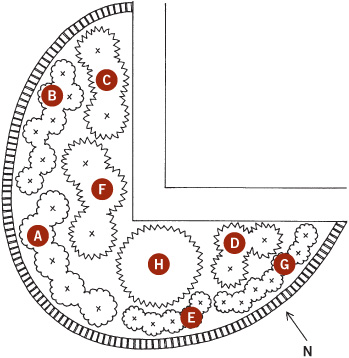
A Amsonia ‘Blue Ice’ (5 plants)
B Ceratostigma plumbaginoides (7 plants)
C Clethra alnifolia ‘Sixteen Candles’ (3 plants)
D Itea virginica ‘Merlot’ (3 plants)
E Sedum spurium ‘Voodoo’ (5 plants)
F Spiraea betulifolia ‘Tor’ (3 plants)
G Veronica ‘Aztec Gold’ (7 plants)
H Viburnum opulus var. americanum ‘Bailey Compact’ (1 plant)
‘BLUE ICE’ BLUESTAR
Slender, rich green leaves in spring and summer, turning bright yellow in fall; small, medium blue flowers in early summer. 12"—18" tall × 18"—24" wide. Full sun to light shade; average to moist but well-drained soil. Zones 4—9.
Suggested alternative: A. tabernaemontana var. montana; fall-flowering ‘Sheffield Pink’ chrysanthemum.
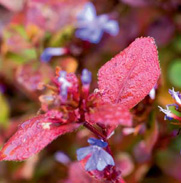
Ceratostigma plumbaginoides
Ceratostigma plumbaginoides
LEADWORT
Oval to oblong, bright green leaves in late spring and summer, turning deep red in fall and lasting well into winter in mild areas; small, bright blue flowers from mid-or late summer through fall. 6"—l2" tall × 1’—2' wide. Full sun to light shade; average, well-drained soil. Zones 5—9. Suggested alternative: Pink-flowered ‘Herrenhausen’ oregano (Origanum laevigatum).
‘SIXTEEN CANDLES’ SUMMERSWEET
Lightly toothed, deep green leaves in spring and summer, turning bright yellow in fall; upright spikes of fragrant white flowers in mid- to late summer. About 3' tall and wide. Full sun to partial shade; moist but well-drained soil. Zones 3—9. Suggested alternative: Another compact summersweet, such as ‘Sweet Suzanne’ or ‘White Dove’.
‘MERLOT’ SWEETSPIRE
Elliptical, deep green leaves in spring and summer, turning rich shades of red (sometimes with orange and yellow too) in fall and often lasting into early winter; arching spikes of fragrant white flowers in early summer. About 3' tall and wide. Full sun to light shade; average to moist but well-drained soil. Zones 5—9. Suggested alternative: Another compact sweetspire, such as Little Henry (‘Sprich’).
‘VOODOO’ TWO-ROW SEDUM Small, succulent, deep red foliage throughout the year; clusters of reddish pink flowers in summer. 3"—6" tall × 1' wide. Full sun to light shade; average, well-drained soil. Zones 3—10.
Suggested alternative: Another reddish-leaved two-row sedum, such as ‘Fuldaglut’ or ‘Dragon’s Blood’; a dark-leaved ajuga, such as Chocolate Chip (‘Valfredda’) or ‘Mahogany’.
‘TOR’ BIRCHLEAF SPIREA
Small, deep green leaves in spring and summer, turning shades of purple, red, orange, and yellow in fall; clusters of small white flowers in late spring (with possible rebloom if sheared lightly after flowering). 3'—4' tall and wide. Full sun to light shade; average, well-drained soil. Zones 4—8. Suggested alternative: A compact blueberry (Vaccinium) cultivar, such as ‘Northland’, ‘North Sky’, or ‘Ornablue’.
‘AZTEC GOLD’ VERONICA
Small, bright yellow leaves from early spring through fall; clusters of purple-blue flowers in late spring and early summer. 6"—8" tall × 12"—18" wide. Full sun to light shade; average to moist but well-drained soil. Zones 3—8.
Suggested alternative: ‘Trehane’ (not quite as bright yellow in leaf).
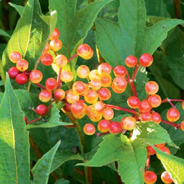
Viburnum opulus var. americanum
Viburnum opulus var. americanum ‘Bailey’s Compact’
‘BAILEY’S COMPACT’ VIBURNUM
Three-lobed, deep green leaves in spring and summer, turning shades of red and purple in fall; clusters of white flowers in early summer, followed by clusters of bright red berries in fall. About 6' tall and wide. Full sun to partial shade; average to moist but well-drained soil. Zones 2—7. Suggested alternative: Another viburnum that’s about the same size with good fall color, such as V. × carlcephalum ‘Cayuga’ or V. dilatatum ‘Catskill’.
A key part of creating a low-maintenance transition between any garden and adjoining lawn areas is planning and installing an easy-care edge. A smooth curve along the outer edge of the border, in combination with a ground-level edging strip, lets you mow easily and trim the perimeter at the same time. Edgings can be as simple as a plastic or metal strip, as elegant as a carefully laid pattern of bricks, or somewhere in between.
Choosing the material. You’ll often see rolls or sections of plastic edging sold at garden and home centers. While these are inexpensive and easy to install, they tend to get pushed out of the ground during the winter and need frequent resetting. Steel or aluminum edging strips cost more and are longer lasting. They aren’t especially attractive, but like plastic, they work well on curved edges. Landscape timbers are fine for straight edges but not practical for curves. Edgings made from pavers or bricks take the most time and money to install, but they are both durable and decorative. Consider choosing a material that complements the color or style of your home; if your house is brick, for instance, using a brick edging for your gardens creates a visual link between your home and the yard.
Installing a raised edge. An elevated edging strip helps to hold garden soil in place, but it also requires an extra trimming step, because your mower won’t be able to get close to the edge. To install, use a sharp spade to dig a shallow trench. For a plastic or metal strip, a trench that’s 3 to 4 inches wide and half the height of the strip is fine. For thicker edgings, make the trench just as wide as your chosen material and about 2 inches deeper than half of its height (if the timbers are 6 inches high, for example, dig the trench 5 inches deep); then add a 2-inch layer of sand to the trench. Set your edging into the trench, tap it in place with a hammer or mallet if needed, and make sure it is level. Replace the soil on the garden side of the edging.
Making a mowing strip. An edging strip that’s set flush with the soil is also called a mowing strip, because you can run a mower’s wheels right along it, neatly trimming the grass along that edge while you’re doing your regular mowing. As with a raised edging, you install a flat edging by digging a shallow trench that’s as wide as the strip you want to make; in this case, though, make the trench 2 inches deeper than the total height of the edging material. (If you’re using pavers that are 2 inches high, for instance, make the trench 4 inches deep.) Spread a 2-inch layer of sand in the trench, lay the edging materials in place, and make sure they are level.
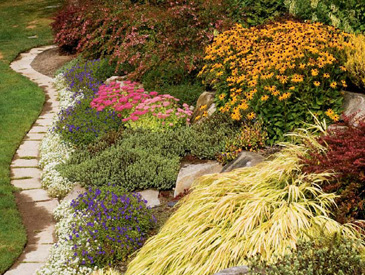
Flat edging for easy mowing.
Wise plant choices can make the difference between container combinations that fizzle out by midsummer and those that look better and better as the growing season goes on. Instead of depending on transplants that are filled with flowers at spring shopping time, put more emphasis on tender perennials and tropicals. They may not look all that exciting at first, but as soon as the temperatures start to rise, so does their wow factor! Hardy perennials with colorful foliage, ornamental grasses, and even small shrubs are also good candidates for adding multiseason interest to your container combinations.
Sun-drenched sites can support an exciting array of eye-catching flowers and foliage plants that look glorious in autumn containers. Containers can dry out quickly in sunny conditions, however, so plantings may need frequent watering to stay lush throughout the growing season. Use large planters that can hold several plants to minimize watering chores (they dry out more slowly than small pots). Self-watering containers are also a blessing if you can’t deal with daily watering during dry spells.
This collection of square and rectangular planters provides a sense of enclosure around a patio without blocking the view beyond. Tropicals and tender perennials, with a few hardier perennials for long-lasting foliage interest, bloom in bright colors that hold up well even in strong summer sun. At its best from late summer to frost, when cooler temperatures and less-intense sunlight allow blooms and leaves to develop their richest colors, it needs little care: Keep soil as evenly moist as possible (but not waterlogged), and use liquid fertilizer every 2 or 3 weeks to encourage lush growth. Pinch off flower spikes on coleus, and deadhead heliotrope and gloriosa daisy to encourage bloom for months. To save for next year, pot up cold-tenders and bring them indoors before frost. In many areas, heuchera and yucca can stay outdoors, but for extra protection, transplant them into an empty space in your garden over the winter.
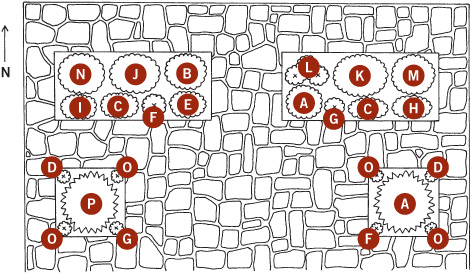
A Alternanthera dentata ‘Purple Knight’ (1 plant)
B Angelonia ‘Angelface Blue’ (1 plant)
C Catharanthus roseus ‘First Kiss Blueberry’ (2 plants)
D Heliotropium arborescens ‘Fragrant Delight’ (2 plants)
E Heuchera ‘Tnheu041' (1 plant)
F Ipomoea batatas ‘Sweet Caroline Light Green’ (2 plants)
G Ipomoea batatas ‘Sweet Heart Red’ (2 plants)
H Lysimachia congestiflora ‘Outback Sunset’ (1 plant)
I Lysimachia congestiflora ‘Persian Chocolate’ (1 plant)
J Pennisetum setaceum ‘Eaton Canyon’ (1 plant)
K Rudbeckia hirta ‘Prairie Sun’ (1 plant)
L Salvia coccinea ‘Lady in Red’ (3 plants)
M Solenostemon scutellarioides ‘Blackberry Waffles’ (1 plant)
N Solenostemon scutellarioides ‘Sedona’ (1 plant)
O Verbena tenuisecta ‘Imagination’ (4 plants)
P Yucca ‘Gold Sword’ (2 plants)
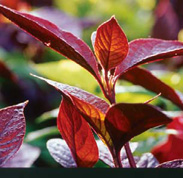
Alternanthera dentata ‘Purple Knight’
‘PURPLE KNIGHT’ ALTERNANTHERA
Glossy, deep maroon leaves all through the frost-free season. 18"—24" tall and wide. Full sun to partial shade; average to evenly moist but well-drained soil. Zones 9—11; grow as an annual elsewhere. Suggested alternative: ‘Gail’s Choice’ (very similar) or ‘Rubiginosa’, also known as ‘Ruby’ or ‘Wave Hill’ (also similar-looking but usually 24"-30" tall and wide).
‘ANGELFACE BLUE’ ANGELONIA
Narrow, deep green leaves through the growing season; loose, spikelike clusters of fragrant, deep purple-blue blooms with white centers from late spring or early summer to frost. About 18" tall × 12"—18" wide. Full sun; average, well-drained soil. Zones 9—11; grow as an annual elsewhere. Suggested alternative: ‘AngelMist Purple Improved’ (may be slightly taller).
‘FIRST KISS BLUEBERRY’ ROSE PERIWINKLE
Oblong, glossy, bright green leaves through the growing season; flat-faced, rich purple flowers with darker centers from early summer to frost. About 1' tall and wide. Full sun; average, well-drained soil. Zones 9—11; grow as an annual elsewhere. Suggested alternative: Verbena tenuisecta ‘Illumination’ or another purple verbena.
‘FRAGRANT DELIGHT’ HELIOTROPE
Deeply veined, deep green leaves through the growing season; clusters of richly fragrant, medium to light purple flowers from early summer to frost. 12"—18" tall and wide. Full sun; average to moist but well-drained soil. Zones 9—11; grow as an annual elsewhere.
Suggested alternative: ‘Iowa’ or another fragrant, purple-flowered cultivar.
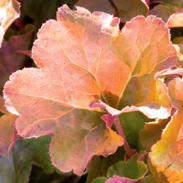
Heuchera ‘Tnheu041'
Heuchera ‘Tnheu041'
‘DOLCE CRÈME BRÛLÉE’ HEUCHERA
Peachy orange foliage is present year-round (coloring is most intense in spring and fall); airy clusters of tiny white flowers in summer. About 1’ tall and wide in leaf; to 18" tall in bloom. Full sun to light shade; average, well-drained soil. Zones 4—8. Suggested alternative: Impatiens ‘Tango’ (green foliage, deep orange flowers).
‘SWEET CAROLINE LIGHT GREEN’ SWEET POTATO VINE
Deeply lobed, bright yellow to greenish yellow foliage on trailing stems through the frost-free season. About 6" tall × 3' or more in length. Full sun to partial shade; average to moist but well-drained soil. Zones 10—11; grow as an annual elsewhere. Suggested alternative: ‘Sweet Heart Light Green’ (similar color but with heart-shaped foliage).
‘SWEET HEART RED’ SWEET POTATO VINE
Heart-shaped, reddish brown to pinkish orange foliage on trailing stems through the frost-free season. About 6" tall and 3' or more in length. Full sun to partial shade; average to moist but well-drained soil. Zones 10—11; grow as an annual elsewhere. Suggested alternative: ‘Sweet Caroline Bronze’ (somewhat similar colors but with lobed leaves).
‘OUTBACK SUNSET’ LOOSESTRIFE
Bright yellow to greenish yellow leaves with green markings through the growing season; clustered yellow flowers in spring and summer. About 4" tall × 8"—12" wide. Full sun to full shade; average to moist but well-drained soil. Zones 8—10; grow as an annual elsewhere.
Suggested alternative: L. congestiflora ‘Golden Harvest’ (solid yellow leaves); L. nummularia ‘Aurea’ (smaller, bright yellow foliage).
‘PERSIAN CHOCOLATE’ LOOSESTRIFE
Deep purple to purple-green leaves through the growing season; clustered yellow flowers in spring and summer. About 4" tall and 8"—12" wide. Full sun to full shade; average to moist but well-drained soil. Zones 8—l0; grow as an annual elsewhere. Suggested alternative: L. congestiflora ‘Persian Carpet’ (purple-centered green leaves); Tradescantia pallida (larger, rich purple leaves).
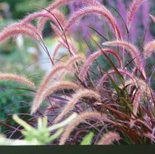
Pennisetum setaceum ‘Rubrum
‘EATON CANYON’ RED FOUNTAIN GRASS
Slender, glossy, deep purplish red blades all through the frost-free season; brushy tan flower spikes heavily blushed with pink to burgundy from mid- or late summer to frost. 2'— 3' tall × about 1’ wide. Full sun; average to moist but well-drained soil. Zones 10—11; grow as an annual elsewhere. Also sold as ‘Dwarf Rubrum’ or ‘Red Riding Hood’.
Suggested alternative: A compact, dark-leaved Phormium, such as ‘Tom Thumb’; a dark-leaved Cordyline, such as ‘Red Sensation’, ‘Red Star’, or C. baueri.
‘PRAIRIE SUN’ GLORIOSA DAISY
Hairy, medium green leaves from spring through fall (basal clumps may be evergreen); large, daisylike blooms with green centers and yellow-tipped orange petals from late spring or early summer through fall (with deadheading). About 2' tall × 1’ wide. Full sun; average, well-drained soil. Zones 4—8 (may be short-lived). Suggested alternative: Any R. hirta selection in the same height range.
‘LADY IN RED’ SALVIA
Bright green leaves through the growing season; spikes of bright red flowers from early summer to frost. 18"—24" tall × about 1’ wide. Full sun to light shade; average, well-drained soil. Zones 9—11; grow as an annual elsewhere. Suggested alternative: S. roemeriana (about 1' tall); a red-flowered cultivar of autumn sage (S. greggii), such as ‘Cherry Chief’ or ‘Maraschino’, or of scarlet sage (S. splendens), such as ‘Flare’.
Solenostemon scutellarioides ‘Blackberry Waffles’
‘BLACKBERRY WAFFLES’ COLEUS
Large, deeply veined, deep purple leaves through the frost-free season. 24"—30" tall × about 1’ wide. Full sun to partial shade; average to moist but well-drained soil. Zones 10—11 grow as an annual elsewhere. Suggested alternative: Another dark-leaved, such as ‘Mars’ (‘Purple Duckfoot’).
‘SEDONA’ COLEUS
Clear orange to brick red foliage through the frost-free season. 1’—2' tall × about 1’ wide. Full sun to partial shade; average to moist but well-drained soil. Zones 10—11; grow as an annual elsewhere. Suggested alternative: Another coleus in the same color range, such as ‘Copper Glow’, ‘Klondike’, or ‘Rustic Orange’.
‘IMAGINATION’ MOSS VERBENA
Lacy, bright green leaves from spring through fall; clustered, violet-purple flowers from late spring through light frost. About 1’ tall × 18"—24" wide. Full sun; average to moist but well-drained soil. Zones 7—l0; grow as an annual elsewhere. Suggested alternative: Another low-growing purple verbena, such as ‘Babylon Purple’.
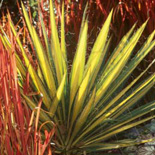
Yucca ‘Gold Sword’
Yucca ‘Gold Sword’
‘GOLD SWORD’ YUCCA
Slender, spiky green leaves with wide yellow centers all year long; tall stalks of creamy white bells on older plants in summer. 18"—24" tall and wide. Full sun to light shade; average, well-drained soil. Zones 5—9.
Suggested alternative: Another yellow-variegated yucca in the same size range, such as Y. filamentosa ‘Color Guard’ or ‘Bright Edge’.
Bringing tender plants inside in fall is only half of the challenge—the other half is figuring out where to put them! Some need warmth and light to keep growing actively, others prefer to rest in a cool, dark place; a few can get by with either treatment. Experiment with the plants you have under the conditions you have available; over time, you’ll learn the perfect spot for each of your favorites. Check all indoor plants every week or two for signs of pest problems, and spray with insecticidal soap if needed. Keep all dead leaves and flowers picked off too, and dust lightly to keep the leaves clean and healthy.
Warm thoughts. The conditions within the average home can keep many tender plants — including begonias, dracaenas, and hibiscus, to name just a few — growing and even flowering all through the winter. Keep the nighttime temperatures at least 55°F, and provide as much light as possible; if sunny window space is limited, set them under fluorescent plant lights. Indoor air tends to be very dry, but you can increase humidity around plants by setting them on shallow trays of pebbles with enough water to almost cover the stones. Water and fertilize regularly to support vigorous growth, and pinch off shoots as needed to encourage dense, bushy growth.
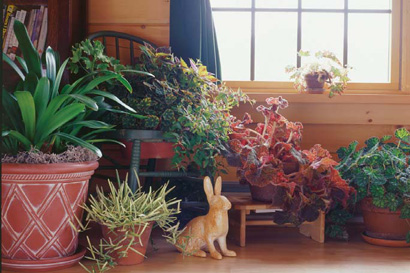
Overwintering tender plants indoors.
Cool and bright’s all right. A number of tender plants—among them, flowering maples (Abutilon), fuchsias, impatiens, and geraniums (Pelargonium)—can overwinter happily in a bright but cool spot indoors (about 50°F during the day and 35° to 40°F at night). A sunny, closed-off spare room or an enclosed but unheated porch is ideal. Boost humidity as explained above. They won’t grow as fast as those in warm conditions, so they don’t need water or fertilizer quite as often.
Keep these in the dark. Some tender plants can survive the cold months without any light at all; these include caladiums, cannas, dahlias, and other plants that grow from bulbs, corms, rhizomes, and tuberous roots. After digging, let them dry for a week or two in an airy, frost-free place. Gladiolus bulbs usually store best when dry; other bulbs are usually buried in a bag or box of barely moist peat moss, vermiculite, or sawdust. Sprinkle with additional water as needed through winter: Keep them moist enough to prevent shriveling, but not so wet that they rot. Most bulbs do well when stored at 40° to 50°F; ca-ladiums are better at 55° to 60°F.
Vibrant and versatile, container gardens are invaluable for adding seasonal interest to decks, porches, patios, and a variety of other settings. They really shine in summer and fall, but with some advance planning — and some extra attention in autumn — potted plantings can provide beauty through the colder months as well. Whether you leave the plants in place year-round or pop them in after you remove your summer annuals, they’ll add a welcome cheerful splash of color. Just remember to keep them watered—they can dry out even in wintertime. A few inches of mulch will also help keep container plants in prime form, just as it does for those growing in the ground.
Berry nice ideas. Whether grown alone or paired with evergreen foliage, berry-producing shrubs are a perfect off-season addition to outdoor containers. Compact female selections of evergreen or deciduous hollies (Ilex), such as ‘Red Sprite’ winterberry, are excellent choices; remember, though, that you’ll need a compatible male holly nearby during the summer bloom season to get the berries. The bright, clustered fruits of pyracantha are also superb for winter color. For best results with potted shrubs, look for cultivars that are rated at least one—and ideally two—hardiness zones colder than yours (if you live in Zone 6, for instance, look for those reported to be hardy in Zone 4). While most berry-bearing shrubs prefer sun during the growing season, they can survive just fine with shade to partial shade all winter.
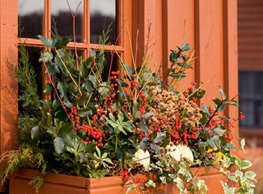
A winter-themed window box.
Winter foliage and flowers. A wide variety of foliage plants are great candidates for winter containers. Evergreen conifers are excellent for height and color, and they come in a range of colors, including dark to light green, purplish, silver-blue, and yellow-gold. Yuccas, too, have a dramatic winter presence—especially those with variegated foliage, such as ‘Gold Sword’ and ‘Color Guard’. Boxwoods can be left to grow naturally or trimmed into a variety of shapes. Evergreen ground covers, such as pachysandra, thymes, liriope, and vinca, work well as fillers around taller-growing companions. You can even enjoy winter flowers in mild climates; try camellias, heaths (Erica), pansies, and primroses.
Make outdoor arrangements. If you live in a very cold climate, or if you simply don’t want to fuss with live plants in pots, there are plenty of other fun ways to dress up containers for winter. Cut pine, spruce, cedar, or other evergreen branches and push them directly into the potting soil. Or make a tripod with bamboo stakes, and wire evergreen branches to them. Dress containers up with natural “ornaments” such as pinecones, berries, grasses, and seed heads. For extra color, use cut branches of shrubs with colorful stems. Shrubby dogwoods (selections of Cornus alba and C. stolonifera) are superb —’Cardinal’ has bright red bark; ‘Bud’s Yellow’ and ‘Silver and Gold’ have yellow stems; and ‘Midwinter Fire’ is orange, red, and yellow.
Container-planting options for shady sites sure don’t get the same attention that sunny pots and planters do — and that’s a pity. Containers that are in shade for at least part of the day tend to hold moisture longer, so you don’t need to water them nearly as often. Besides saving you time, that gives you more design flexibility, since you can mix smaller individual pots with larger, multiplant containers without worrying about watering every single day. Even wind-exposed containers such as window boxes and hanging baskets are often much easier to maintain in shady areas than in full sun.
Just like shaded ground-level gardens, autumn container plantings rely primarily on foliage features, such as distinctive textures and out-of-the-ordinary colors. Once you’ve chosen a few particularly good foliage plants for spring-through-fall interest, you can tuck in a few shade-tolerant late-bloomers for accents. Perennials are especially pleasing for shady containers, because they provide the seasonal variety that common shade annuals simply can’t match. From a practical standpoint, they save you money, too! You can buy very small starter pots of the perennials, use them in your containers for a season, then plant the filled-out clumps in your garden at the end of the growing season.
This design features a collection of half-barrel planters and window boxes to accent a shaded garden shed. The display is surprisingly flower-filled early in the season, thanks to the ajuga, bergenia, foamflowers, Solomon’s seal, and spotted deadnettle. Some bloom continues into summer with the foamy bells and hosta, followed by the lilyturf and toad lily in late summer and fall. Besides the dependable spring and summer foliage interest from all of the plants, several of them — including the bergenias, foamflowers, and Solomon’s seal — also contribute a striking color change in autumn. Lots of them will look good through most or all of the winter as well.
During the growing season, simply water as needed, fertilize a few times, and occasionally snip off any spent blooms or discolored leaves.
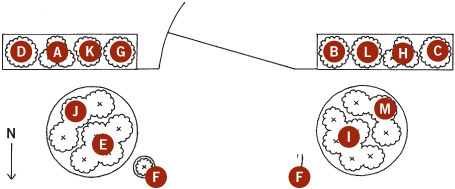
A Ajuga reptans ‘Mahogany’ (1 plant)
B Athyrium ‘Burgundy Lace’ (1 plant)
C Bergenia ‘Pink Dragonfly’ (1 plant)
D Hakonechloa macra ‘All Gold’ (1 plant)
E × Heucherella ‘Burnished Bronze’ (3 plants)
F Hexastylis shuttleworthii ‘Callaway’ (2 plants)
G Hosta ‘Little Sunspot’ (1 plant)
H Lamium maculatum ‘Pink Chablis’ (1 plant)
I Liriope muscari ‘Pee Dee Gold Ingot’ (3 plants)
J Polygonatum falcatum ‘Variegatum’ (3 plants)
K Tiarella ‘Sugar and Spice’ (2 plants)
L Tiarella ‘Tiger Stripe’ (2 plants)
M Tricyrtis hirta ‘Miyazaki Gold’ (3 plants)
‘MAHOGANY’ AJUGA
Glossy, deep purple-black leaves through the growing season and lasting through much or all of the winter; short spikes of blue flowers in spring. 4"—6" tall × 8"—12" wide. Partial shade; average, well-drained soil. Zones 4—8.
Suggested alternative: Another dark-leaved ajuga, such as ‘Black Scallop’, ‘Bronze Beauty’, or ‘Purple Brocade’.
‘BURGUNDY LACE’ PAINTED FERN
Lacy, silvery gray fronds with a deep gray-green to purplish gray center stripe through the growing season. About 1’ tall × 1’—2' wide. Partial shade; evenly moist but well-drained soil. Zones 4—8. Suggested alternative: Another painted fern, such as ‘Pewter Lace’ or ‘Ursula’s Red’.
‘PINK DRAGONFLY’ BERGENIA
Oblong, rich green leaves through the growing season, turning deep reddish purple in winter; clustered pink flowers in spring. 6" tall and wide × about 1’ tall in bloom. Full sun to partial shade; average to moist but well-drained soil. Zones 4—8. Suggested alternative: Another bergenia, such as ‘Bressingham Ruby’ or ‘Winter Glow’.
‘ALL GOLD’ HAKONE GRASS
Slender blades of bright yellow to greenish yellow foliage that turn shades of orange to red in fall. About 1’ tall and 18" wide. Partial to full shade; evenly moist but well-drained soil. Zones 5–8. Suggested alternative: ‘Aureola’ (green-and-yellow-striped blades).
‘BURNISHED BRONZE’ FOAMY
BELLS
Lobed, deep red new leaves age to glossy, dark chocolate brown and are usually attractive through the growing season; airy clusters of pink flowers in late spring to early summer and sometimes again later in the season. About 8" tall and wide in leaf; 12"—l8" tall in bloom. Full sun to partial shade; average to moist but well-drained soil. Zones 4—8.
Suggested alternative: Another dark-leaved foamy bells, such as ‘Birthday Cake’ (more compact, with creamy white flowers) or ‘Chocolate Lace’ (with reddish purple foliage).
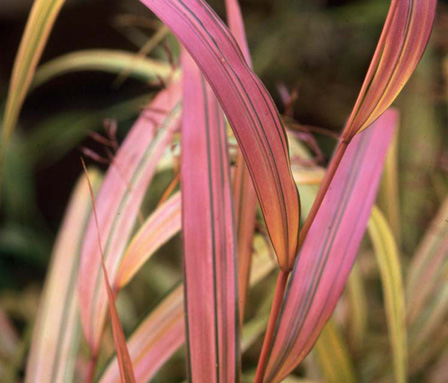
Hakonechloa macra ‘Aureola’
‘CALLAWAY’ WILD GINGER
Glossy, deep green, heart-shaped leaves veined with silvery gray all year long (semievergreen in cold winters); small brown flowers at ground level in spring. About 3" tall × 6"—12" wide. Partial to full shade; average, well-drained soil. Zones 5–8.
Suggested alternative: Another evergreen wild ginger, such as H. naniflorum, H. splendens, or H. speciosa.
‘LITTLE SUNSPOT’ HOSTA
Deep green leaves with large yellow centers and yellow fall color; pale purple flowers in midsummer. About 10” tall × 1’—2' wide in leaf; 12"—l8" tall in bloom. Full sun to partial shade; average to moist but well-drained soil. Zones 3—8. Suggested alternative: Another small hosta, such as ‘Chartreuse Wiggles’ (narrower greenish yellow leaves) or ‘Cracker Crumbs’ (bright yellow to yellow-green leaves with thinner green margins).
‘PINK CHABLIS’ SPOTTED
DEADNETTLE
Small green leaves heavily splashed with silver through the growing season and often through most or all of the winter as well; pink flowers mostly in spring but sporadically to frost. About 6" tall × 1’ wide. Partial to full shade; average to moist but well-drained soil. Zones 4—9. Suggested alternative: Another spotted deadnettle, such as ‘Pink Pewter’ or ‘Shell Pink’.
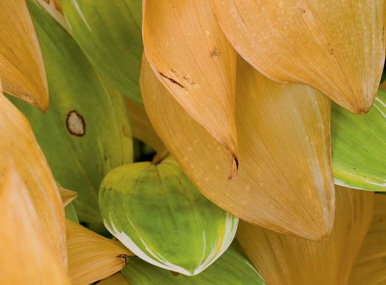
Polygonatum falcatum ‘Variegatum’
‘PEE DEE GOLD INGOT’ BLUE LILYTURF
Narrow, arching, bright yellow to light yellow foliage is effective year-round; purple-blue blooms in mid- to late summer. About 1’ tall and wide. Full sun to partial shade; average to moist but well-drained soil. Zones 6—lo.
Suggested alternative: L. muscari ‘Variegata’ (yellow-edged green leaves); Carex siderosticha ‘Lemon Zest’ (broader, solid yellow blades).
VARIEGATED SOLOMON’S SEAL
Reddish stems carry cream-edged green leaves that turn bright yellow in fall; white flowers in late spring to early summer. 2'—3' tall and about 2' across. Partial to full shade; average, well-drained soil. Zones 5–8.
Suggested alternative: A Solomon’s seal with solid green leaves, such as P. odoratum ‘Chollipo’; Solomon’s plume (Smilacina racemosa).
‘SUGAR AND SPICE’ FOAMFLOWER
Deeply cut, glossy green leaves with deep purple centers through the growing season, often turning bronzy in fall and lasting well into winter; brushy spikes of fragrant, pink-tinged white flowers mostly in spring but sometimes again in fall. About 6" tall and wide in leaf; to about 1’ tall in bloom. Partial shade; average to moist but well-drained soil. Zones 4—8. Suggested alternative: Another foamflower with lacy, dark-centered green leaves, such as ‘Iron Butterfly’ or ‘Mint Chocolate’.
‘TIGER STRIPE’ FOAMFLOWER
Lobed, light green leaves with some purplish markings in spring and summer, often turning deep red to reddish purple in fall and winter; brushy spikes of fragrant pinkish white flowers mostly in spring. About 6" tall in leaf and 12" tall in bloom; 1’—2' wide. Partial shade; average to moist but well-drained soil. Zones 4—8. Suggested alternative: Another foamflower with lobed, dark-marked green leaves, such as ‘Inkblot’ or ‘Pirate’s Patch’.
‘MIYAZAKI GOLD’ TOAD LILY
Yellow-rimmed green leaves all season; purple-spotted white flowers in fall. About 30” tall and 12"—l8" wide. Partial to full shade; evenly moist but well-drained soil. Zones 4—8.
Suggested alternative: T. formosana ‘Gilt Edge’ (with wider yellow leaf edges) or ‘Samurai’ (also with wider edges but more compact).
Pause to admire. While you’re busy catching up with yard work, make sure you take the time to admire the splendid fall combinations all around you. This shady-site grouping features a carpet of bigroot geranium (Geranium macrorrhizum), with bright green, aromatic foliage, flanked by a fall-red Japanese maple (Acer palmatum) and deep green Siberian cypress (Microbiota decussata).